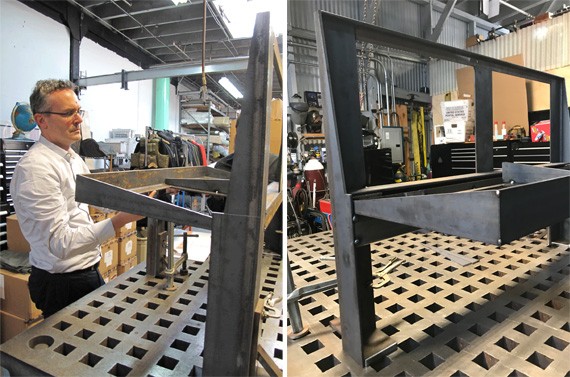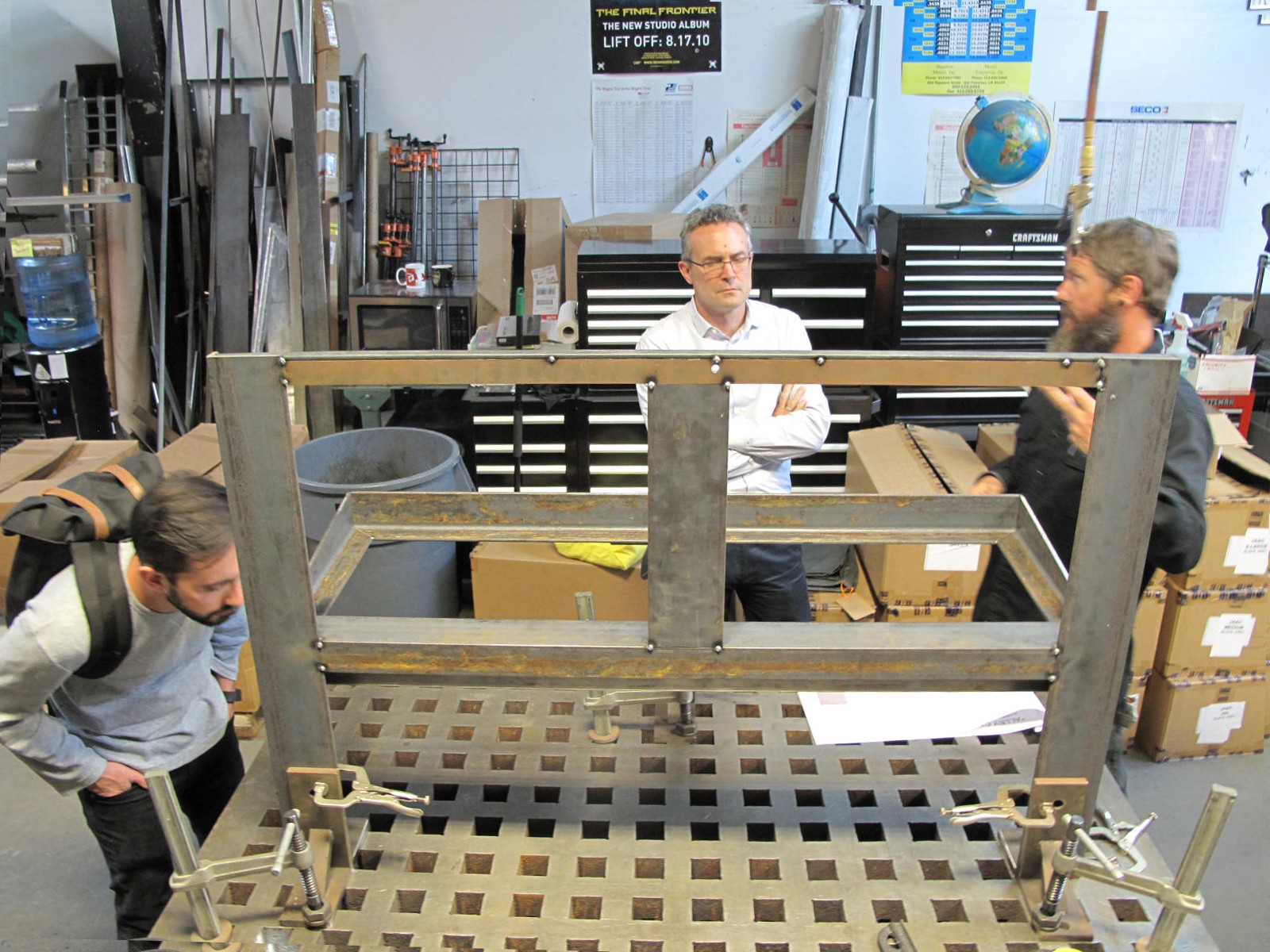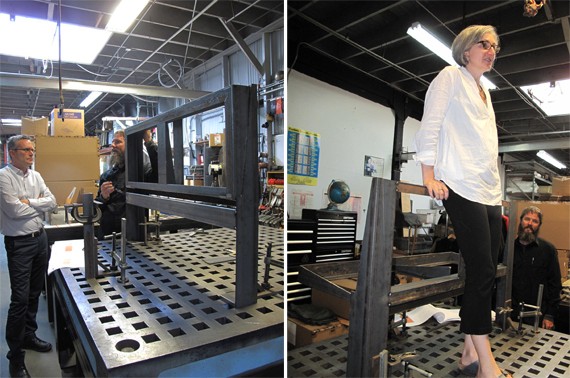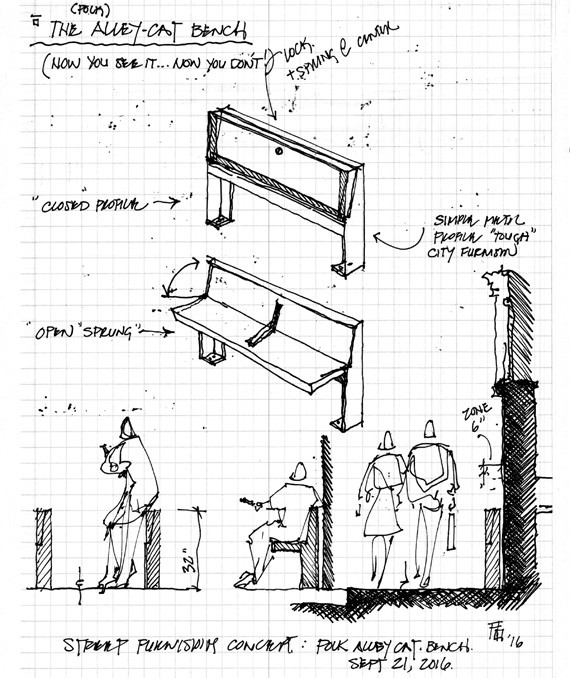Middle Lake Restoration Completed, Golden Gate Park
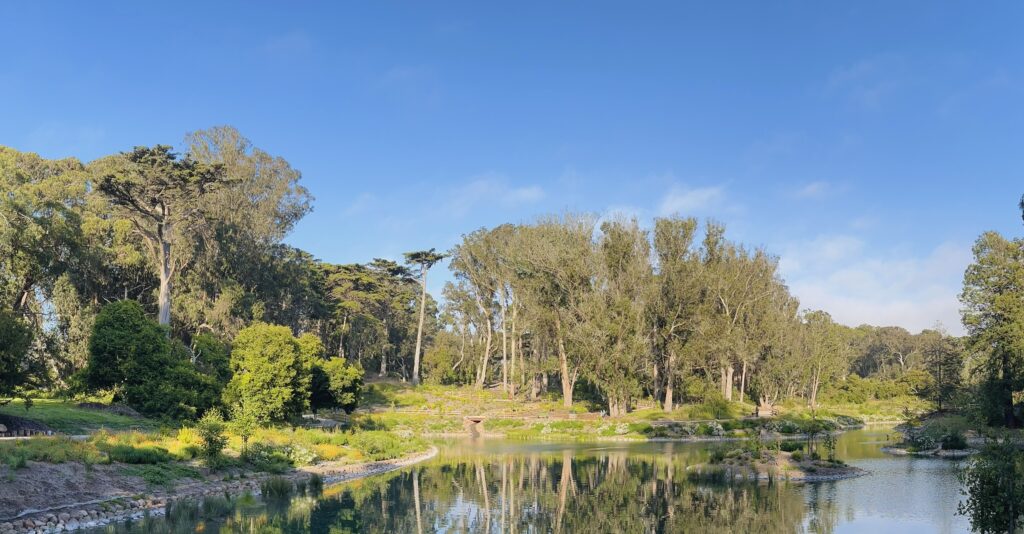
In 2022, INTERSTICE was engaged in an ambitious project to restore Middle Lake in Golden Gate Park, transforming it from a dried-up basin into a vibrant habitat teeming with life. Middle Lake, the missing link in the “Chain of Lakes” series of three interconnected lakes in the west end of San Francisco’s Golden Gate Park, has faced significant ecological decline over the past 150 years since the park was conceived, due to leaks in its clay liner, reduced water depth, algae buildup, and the encroachment of invasive species. Mere improvements were insufficient to save the lake; it required a comprehensive restoration.
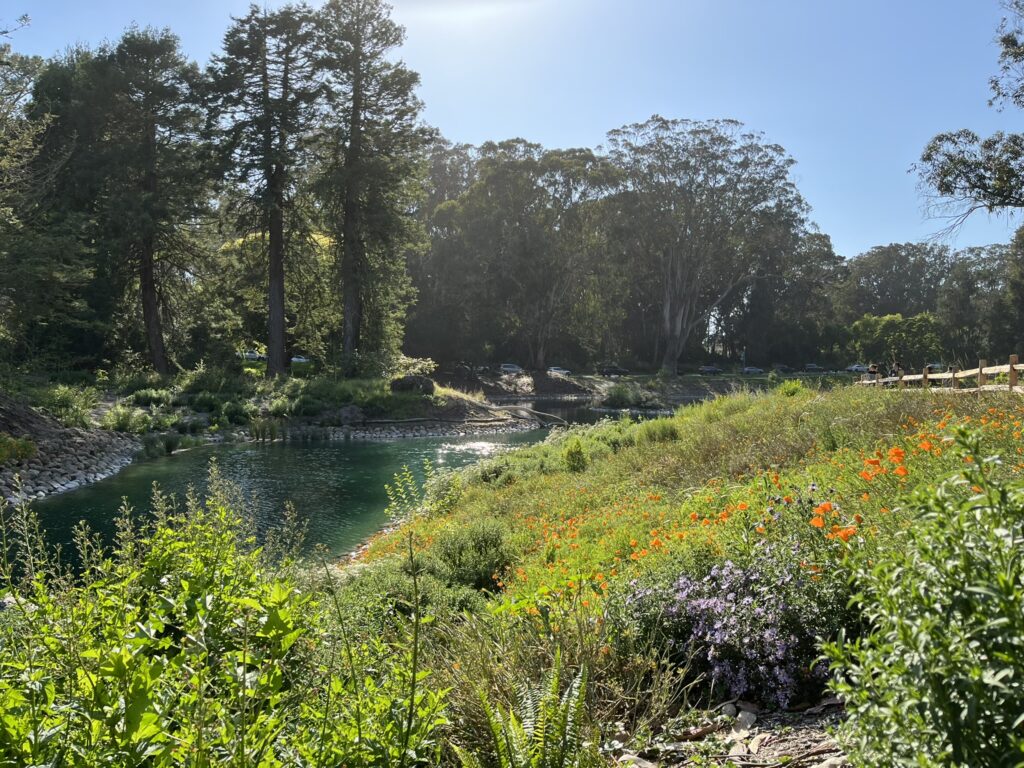
Teamwork Creates A Healthy Community and Habitat
With INTERSTICE in the role of landscape architect on the Construction Team working with San Francisco Recreation and Parks, San Francisco Department of Public Works, Woodard & Curran Civil Engineers, AGS Engineering, Bauman Construction and Catmex Landscaping, over the past nearly two years – Middle Lake has been transformed into a stunning 85,000-square-foot body of sparkling luminous water surrounded by over 10,000 plants including native shrubs, grasses, aquatic plants, wildflowers, native oaks, confers, and dogwood trees. The community input and design effort led by SF Recreation and Parks and developed by Woodard & Curran with the Office of Cheryl Barton engaged numerous stakeholder inputs, including the adjacent residential community, park operations, and multiple city departments related to the environment and its stewardship. The lake is now a lively ecosystem buzzing with insects, bees, and birds and is already home to a goose family that moved in during late construction, gracing the area with six goslings this spring. Raptors tour the skies over the new lake, alongside perching songbirds and numerous shorebirds.
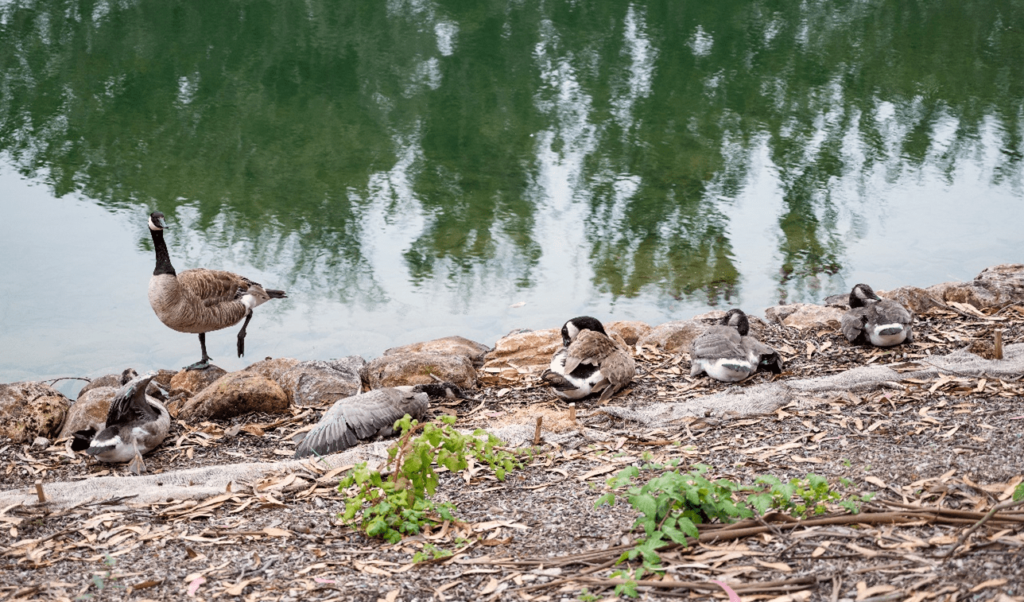 Photo by Oscar Roussel
Photo by Oscar Roussel 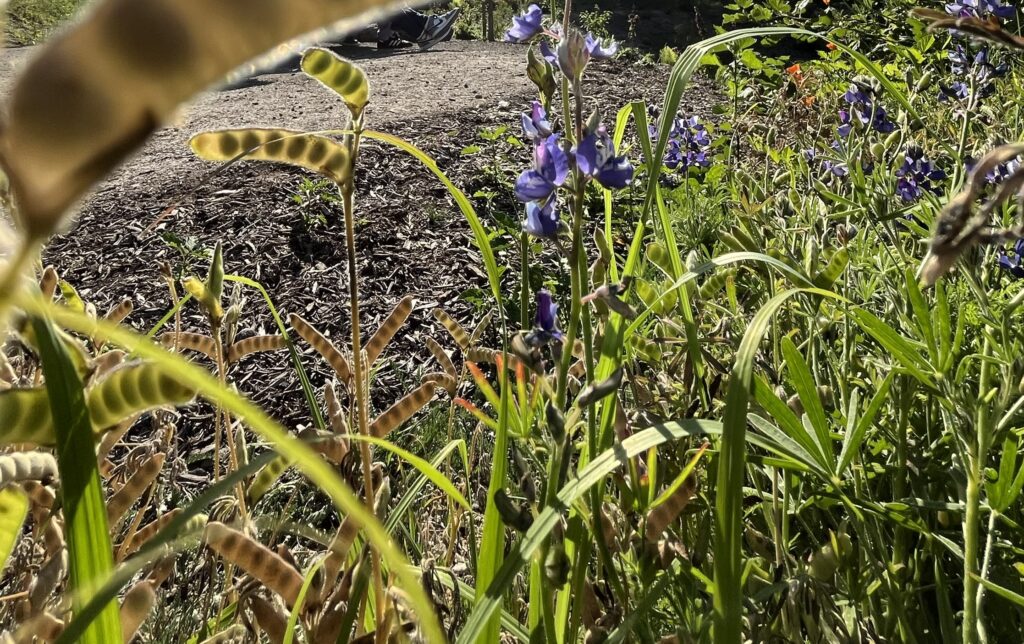
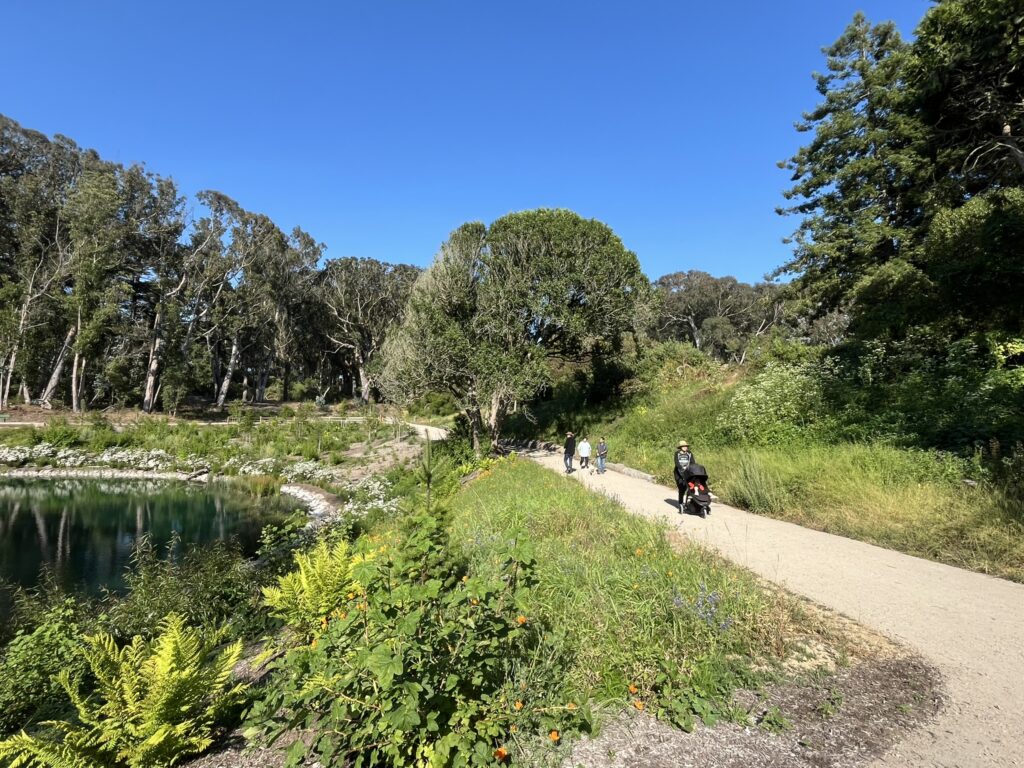
Even prior to its official reopening, the lake had drawn many eager park users, who sneaked through small openings in the fencing to take a look and enjoy walks on its trail that wraps around its half-mile edge. Construction was delayed to accommodate a hawk family that had nested during the construction start-up. Now there is a thriving raptor community soaring above this new and growing riparian ecosystem.
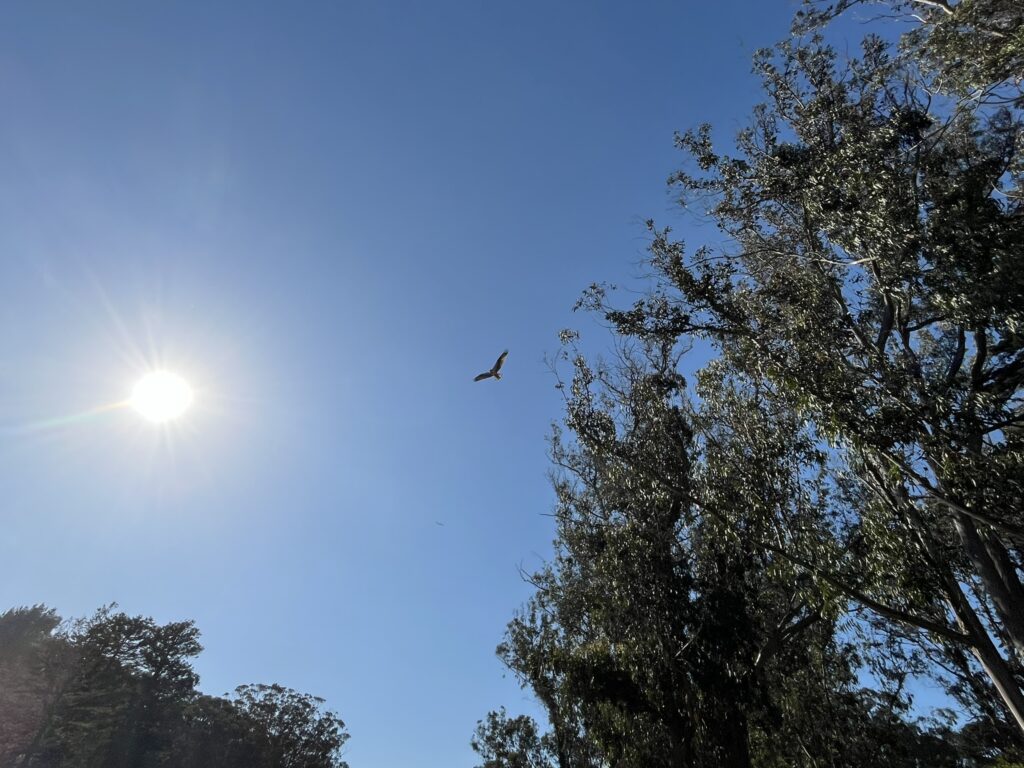
A System Designed to Create a Healthy Aquatic Ecosystem
The restoration process involved an initial assessment of the lake, followed by the removal of 25,000 cubic yards of silt to create and contour a seven-foot-deep basin with two historic islands, and the installation of a new nearly 2-foot-deep clay liner meant to maintain the water level long term. To ensure a healthy water level and good water quality, the design added a cascading stone streambed (the Cascade) that flows adjacent to an intentionally meandering and accessible path, crossed by footbridges, that provides water to the lake below from the park’s Fly-Casting Pools situated to the east of the Lake. Aerators at the lake’s bottom recirculate water and oxygenate the lake’s hydronic column. Overflow from South Lake flows into Middle Lake’s newly designed, stone-lined inlet and circulates out again at the new outlet spillway, into North Lake, connecting the Chain of Lakes with a constant flow of fresh water.
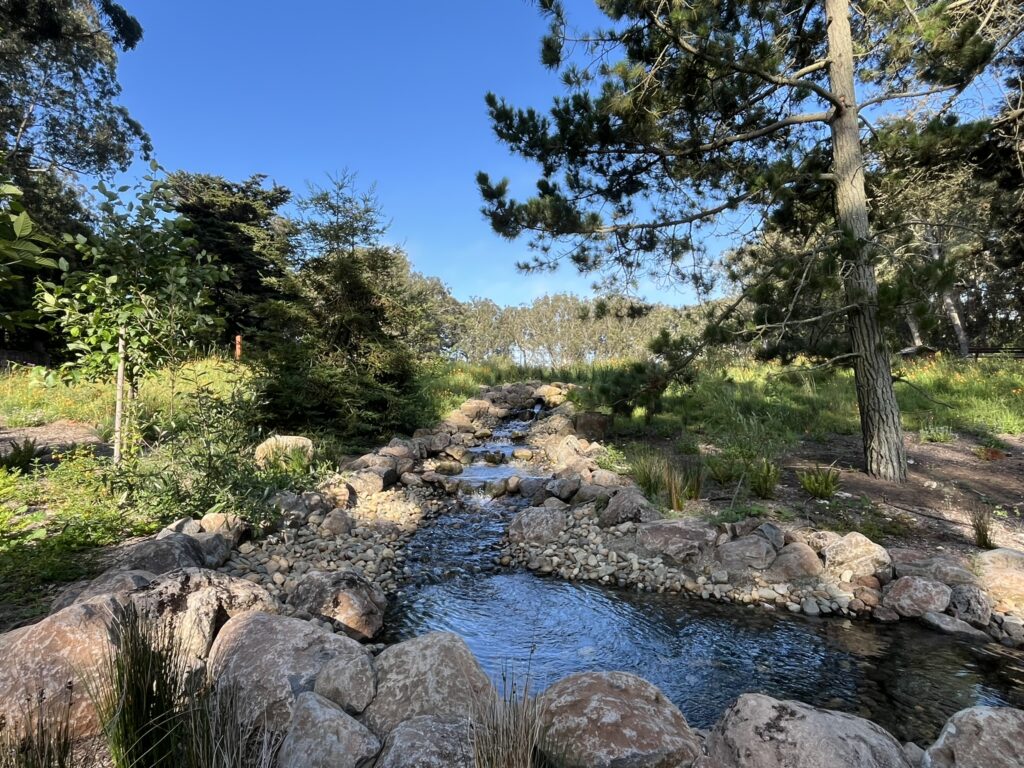
The Cascade stream, along with the south-to-north cross flow, not only significantly reduces algae growth by keeping the water’s surface in motion, creating a healthier aquatic environment, but it also creates the delightful experience for park visitors of the sound of a burbling creek, flowing over natural stone water weirs and check-dams, swirling between deeper pools on its sinuous journey down the eucalyptus-forested slope – a visually and aurally exhilarating and memorable experience.
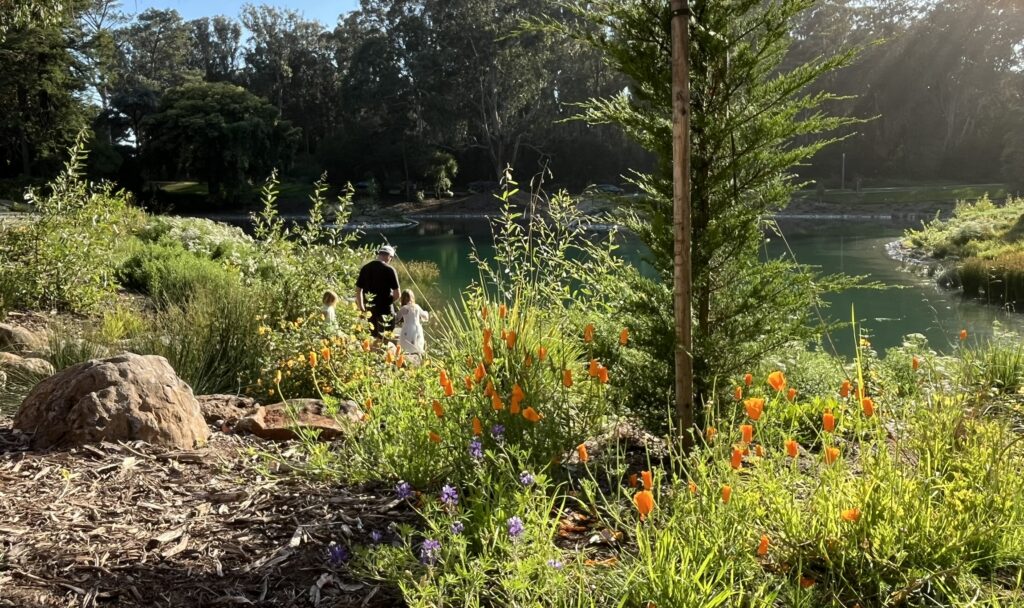
Native Plants Increasing the Biodiversity of Both Flora and Fauna
The planting of native upland species such as California sage, beach strawberry, Coyote Brush, wild rose, California poppy, and lupine attract butterflies and hummingbirds, help stabilize the soil, and provide protected habitats for many of the park’s wildlife. Other important plants that are creating and conserving habitat include newly planted coast live oak trees, coast redwoods, Monterey cypress, alders, and woodland flowering dogwoods, whose canopies will expand to further frame views and provide shade and intimacy along the lakeside paths that circumnavigate the new water body. Numerous native grasses, perennials, ferns, and shrubs fill in the extensive palette of understory flora carefully selected to enhance the biological interdependence of the park’s thriving ecology. The lake’s restoration is expected to attract about 350 different animal species to its shores, including ducks, frogs, salamanders, turtles, dragonflies, and a multitude of bird species.
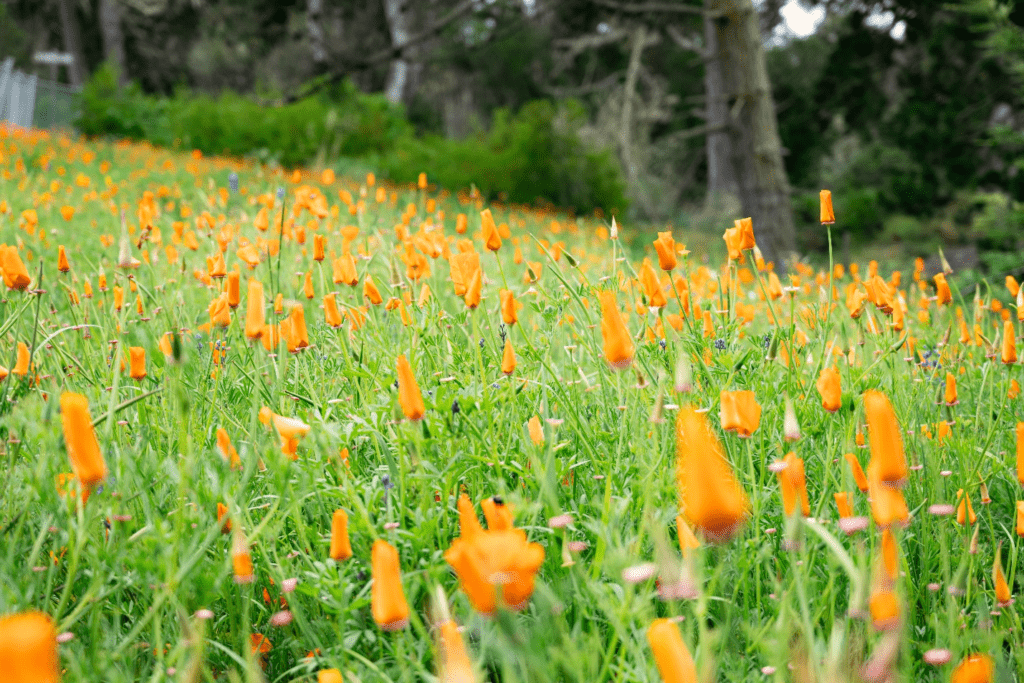 Photo by Oscar Roussel
Photo by Oscar Roussel
Aquatic Specific Design
The design of the lake-reinforced shore and small island prioritizes a sequence of shallow “literal zones” where sunlight and oxygen are easily accessible to aqueous plants and small creatures that find shelter from predation in these teaming shallows at seven locations along the lake’s edge where additionally large fallen tree trunks are strategically positioned to enhance this productive protected edge. Here the base of the food chain is born and develops, allowing the lake ecology to flourish. The largest aquatic shelves are situated at the lake’s outlet and inlet where these 4 to16 inch-deep shallows are built up to create the lake’s natural filters and most generative biological zones.
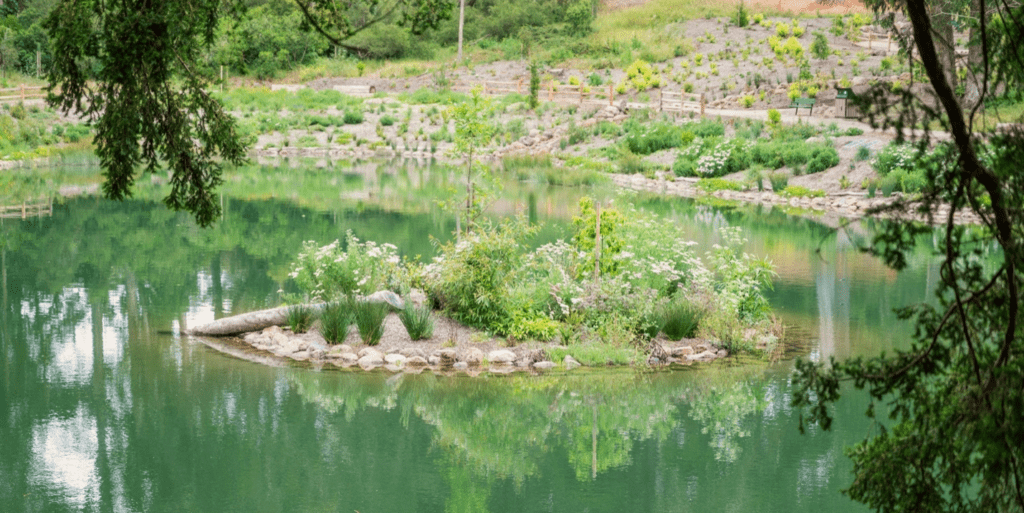 Photo by Oscar Roussel
Photo by Oscar Roussel
Another ecological and environmental benefit of the lake, besides enhancing biodiversity, improving water quality, and increasing habitat, is that it acts as a significant source of carbon sequestration. The lake bed captures and stores carbon from organic matter that settles there. The newly planted vegetation also aids in capturing carbon and helps mitigate the impacts of global warming. Moreover, the lake helps regulate local temperatures, supports groundwater recharge, and contributes to the overall health of Golden Gate Park’s natural environment.
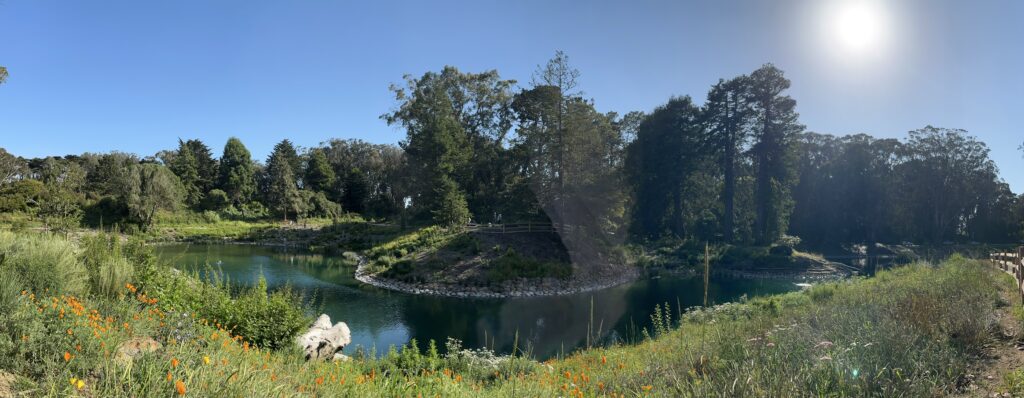
A Place for Plants, Animals and People
As of July 2024, Middle Lake is now open, offering the community a serene place to relax by the water amidst bright, colorful flowers, with ample opportunities for walking, bird-watching, contemplation, and picnicking. The main entrance to the lake is from Chain of Lakes Drive East, which features a small parking lot and connects to the lake’s curvilinear pathway loop. The lake can also be accessed from the fly-casting pools located above the lake by way of a winding path, lined by flowering dogwoods beside the creek, leading down across two wooden footbridges towards the lake edge path loop.
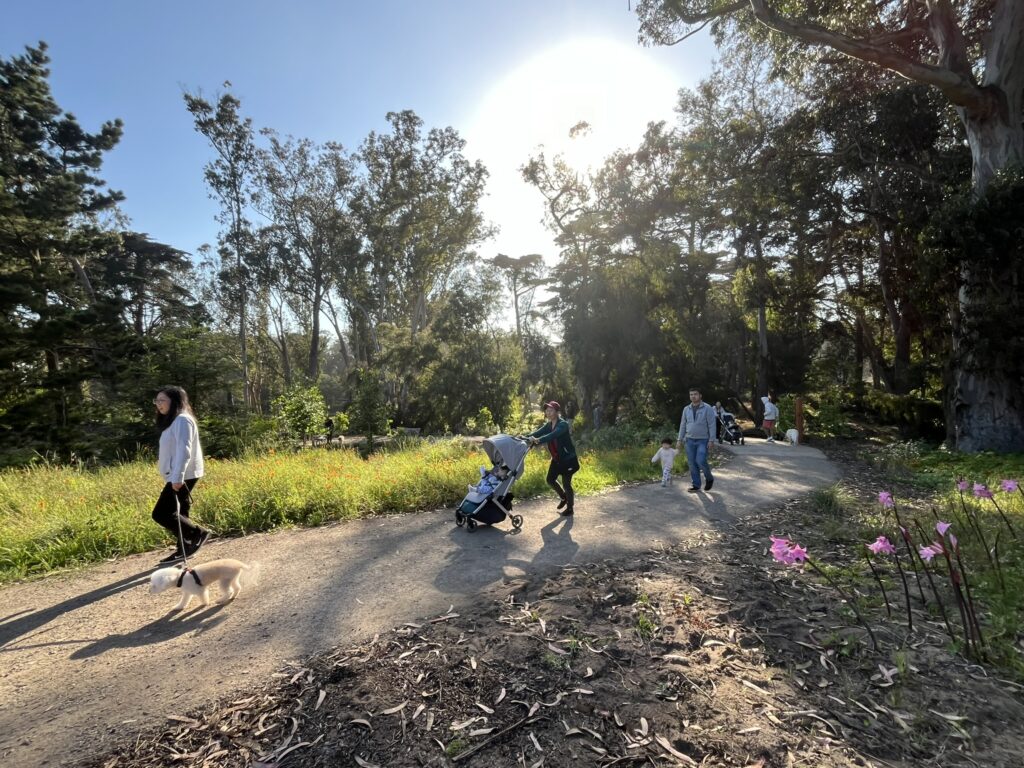
Visitors to Middle Lake will also discover numerous places to enjoy vistas of the lake and contemplate this new environment – the Wedding Lawn on the south that overlooks the lake and is found within a grove of Redwoods, both existing and new and surrounded by benches fabricated from a repurposed and harvested redwood from the site; around the perimeter are park benches to enjoy lake vistas, and large sit-able logs made of harvested eucalyptus trees that were removed due to hazardous conditions and recontouring for the routing of newly proposed pathways; more log seats and sculptural logs along the Cascade path as places to pause, hear and see the adjacent cascade waterway, and spots to allow youth to engage with the natural environment through a series of informal goat paths.
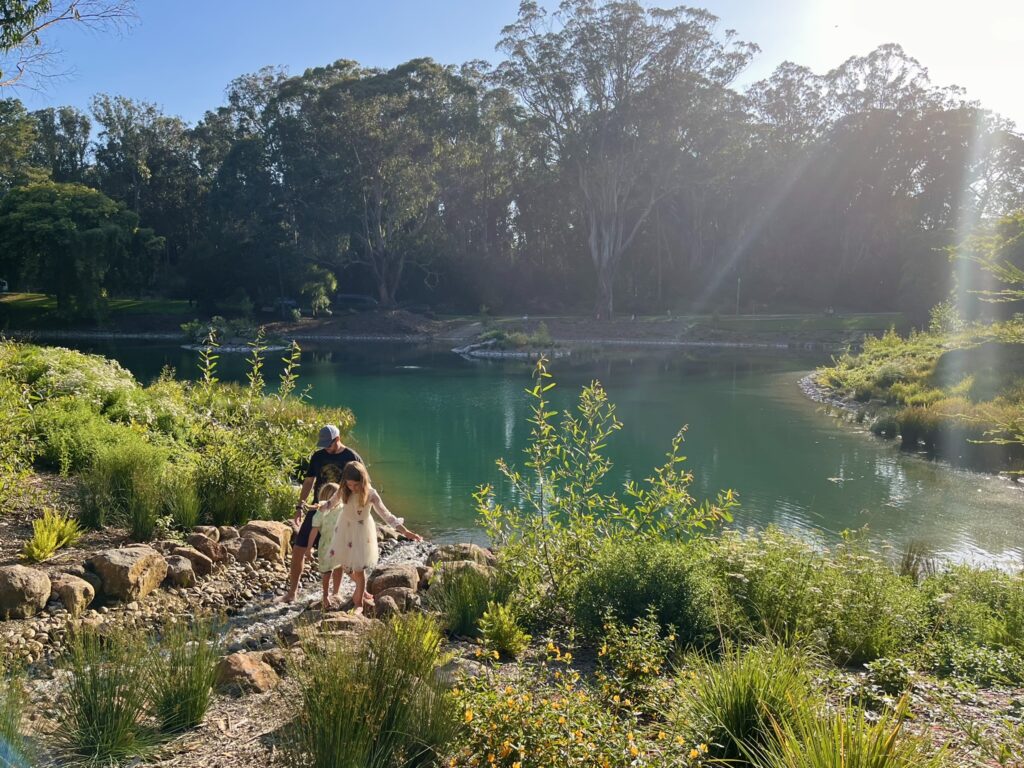
Gratitude for our Team and a Mission Fulfilled
Participating in the conservation of this lake has been an honor and a testament to teamwork. Through restoring Middle Lake’s natural beauty and ecological value, and enhancing its role in our local ecosystem, our team has had the opportunity to contribute to our City community and our region’s health, biodiversity, and resiliency. We are excited to share it with the community and invite everyone to experience its transformation firsthand. This restoration is a testament to the power of thoughtful design and community collaboration. The rejuvenation of this area in Golden Gate Park will have lasting benefits for both the environment and the community – hopefully for at least another 150 years to come. We invite everyone to visit and enjoy!
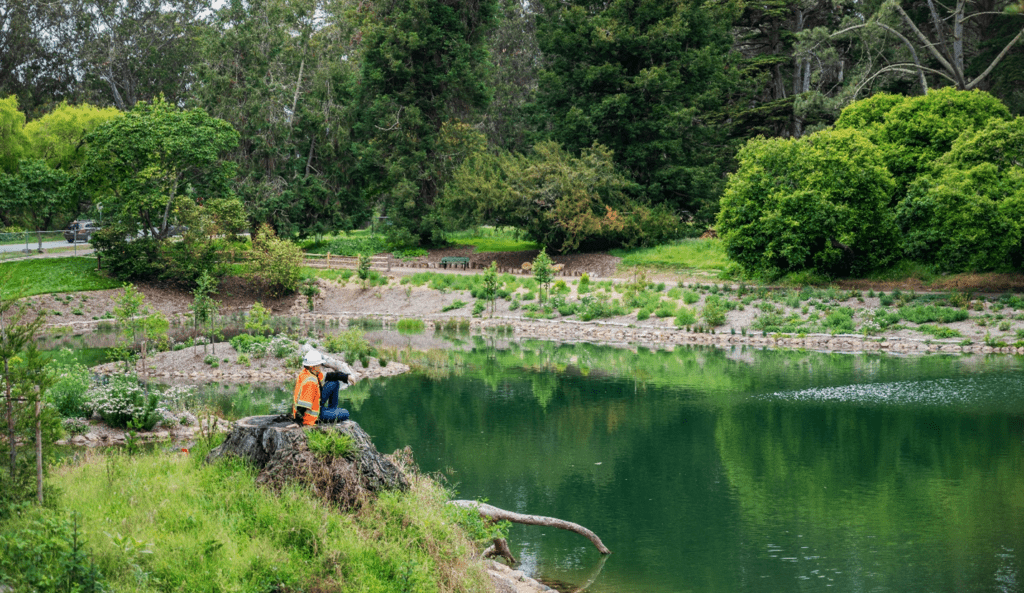 Photo by Oscar Roussel
Photo by Oscar Roussel
Saratoga Beach House
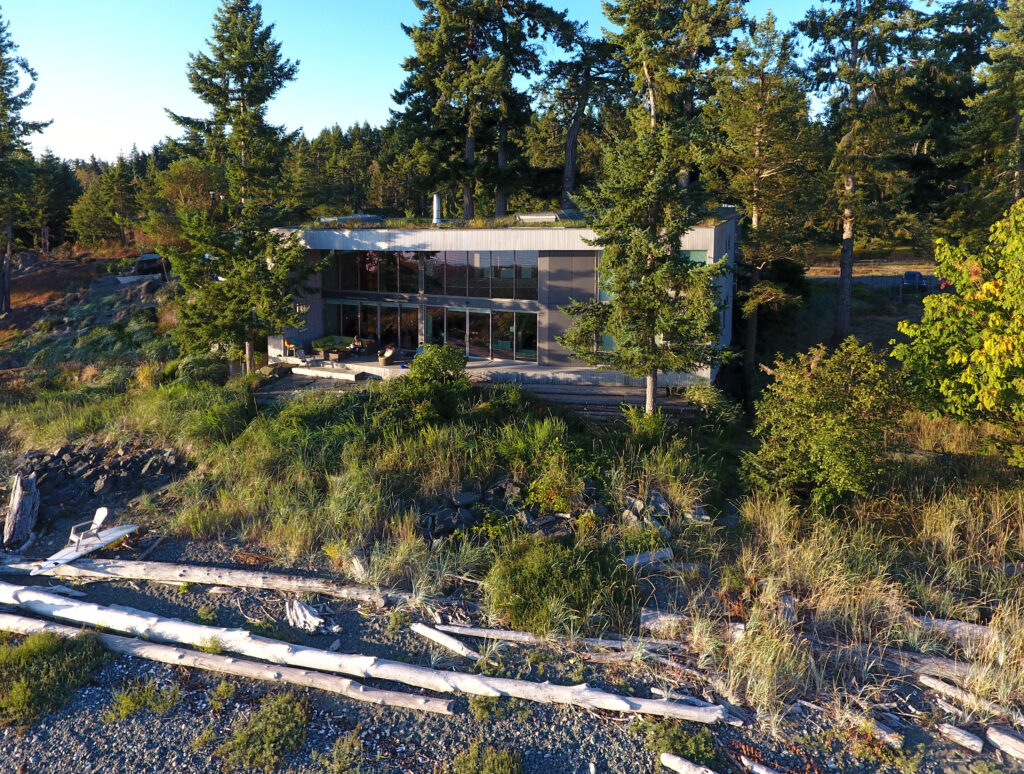
The Beach house: “All Grown-In”
It is always a rare pleasure to get pictures from our happy clients. Especially when they turn the camera on the architecture projects that have transformed their lives – and … even more so when they buy a drone and try out their airborne camera on one of our favorite projects, completed over a dozen years ago! Revisiting the Beach House in this blog as it grows-into the Vancouver Island Coastline is a special delight.
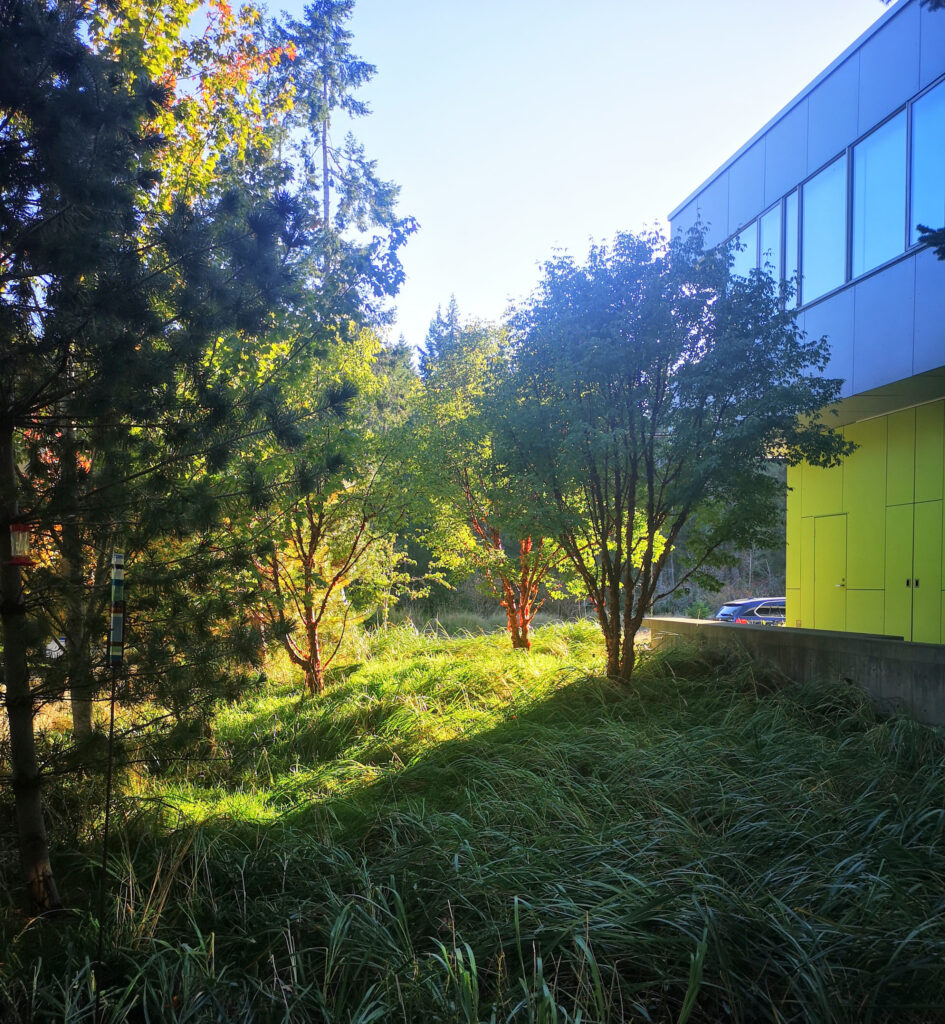
The home was deliberately designed to blend in with the surrounding coastline. It was engineered to be light on the land – from its pilots foundations, hand dug and arranged to avoid the roots of centuries old trees, to its deep rooted invisible sea wall and the inverted dispersal roof drainage. Its radiant all-electric heating, its green roofs, and power independence – is exemplary of what development should look like on these beautiful riparian edges. It is ecologically integrated, invisible to the mature vegetation which has grown to engulf and protect it. Its partnership with the land is a testament to our clients’ commitment to our intimate design process of careful integration of landscape and architecture to benefit both the dweller and the site dwelled within.
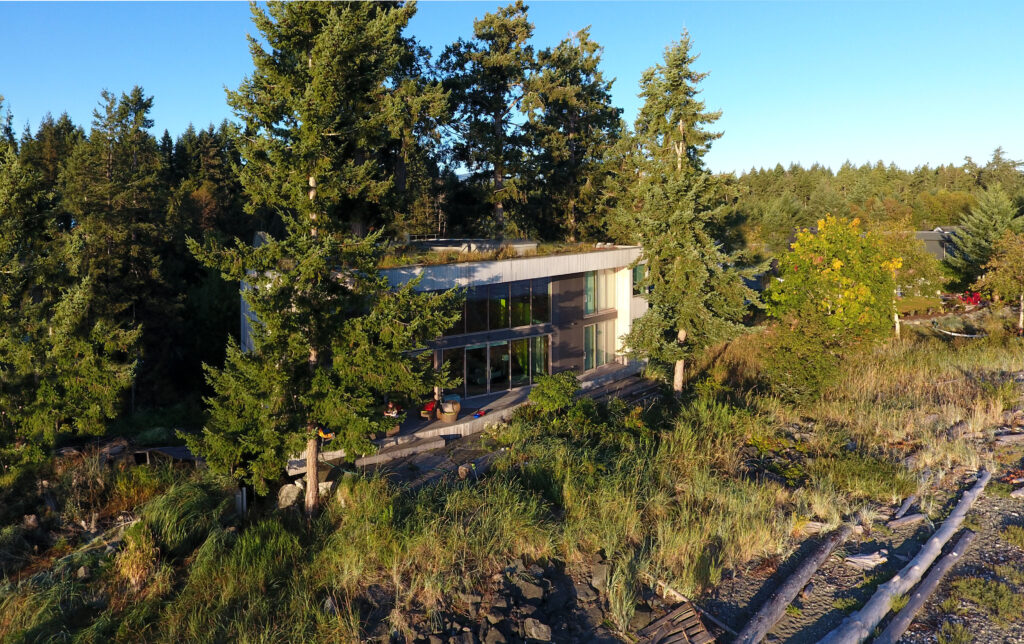
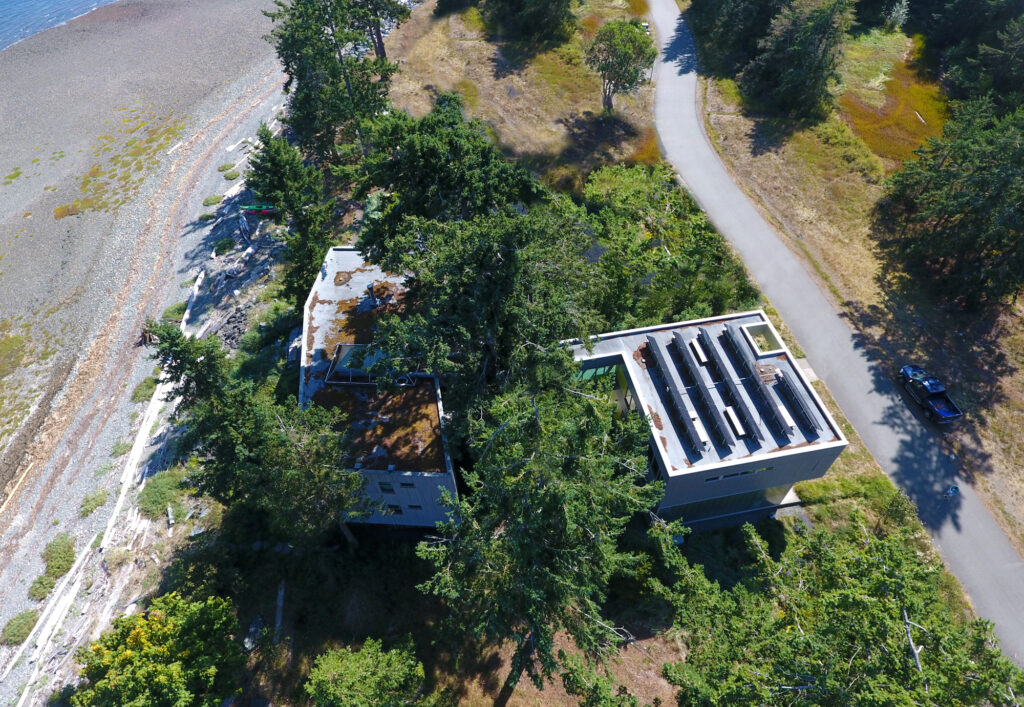
The sea wall has replenished and built up the beach, and has become a grassy gentle rocky outcrop, and its planted driveway and native gardens have comfortably completely grown in. With respect for its habitat the home is taking root, as it floats above the Oyster River flood plain on random peers that thread the roots of the ancient Douglas Firs. The entire project from architecture to site flood mitigation, and ecological controls, was designed to honor the land and the specificity of “Place”. In sympathy with the critical natural resources that are part of how these coastline edges regenerate the house helps preserve and support the richly diverse ecosystems that have flourished here for centuries.
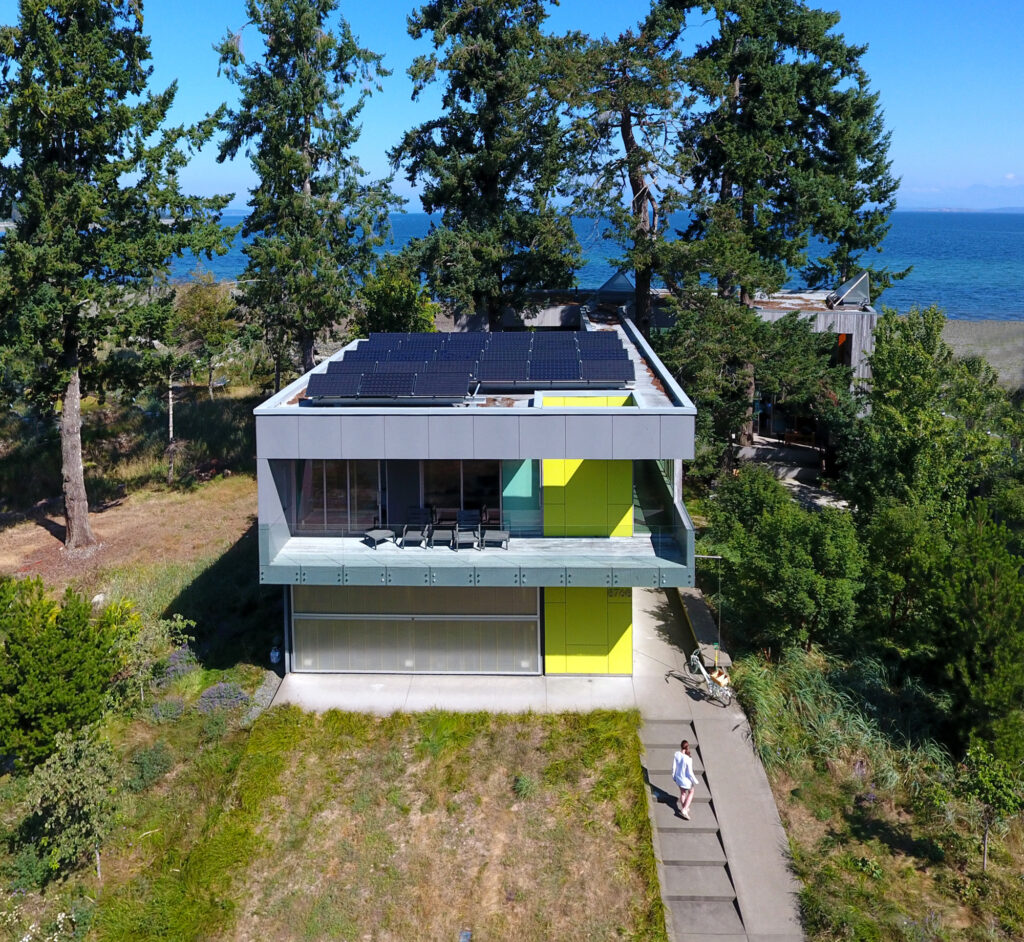
We enjoyed how hard it was to see the house in some shots – like a shy observer camouflaged into the landscape – the home seems to shelter amongst the tees and blend with the logs and tidal debris on the shore, as it peeks out of the riparian ocean front landscape it is intimately invested within.


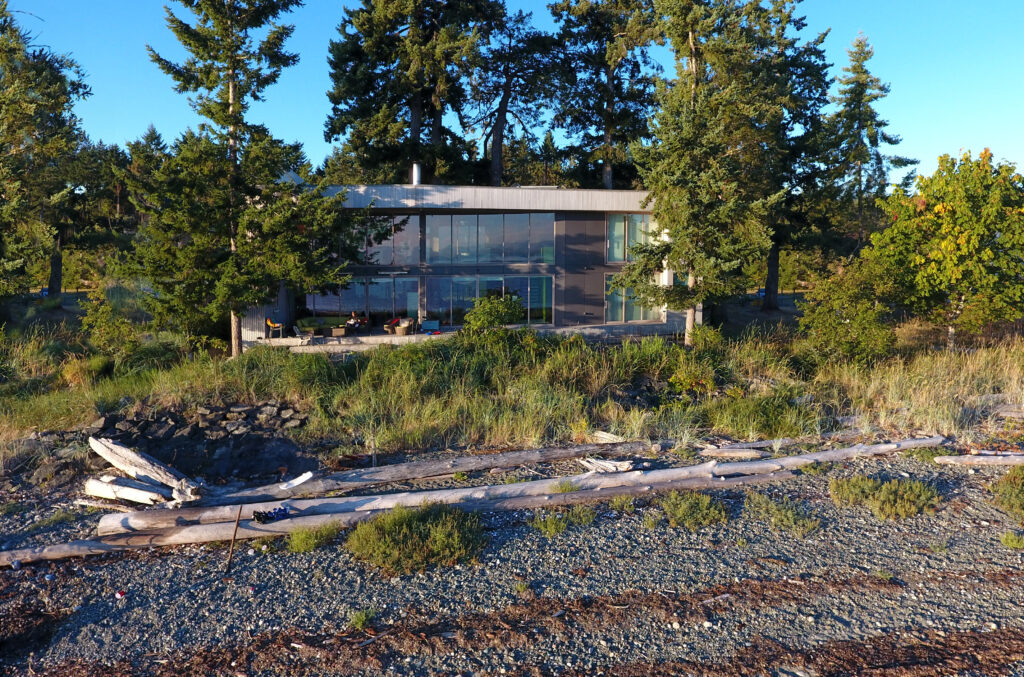

See more about this project here.
Golden Gate Park’s Middle Lake
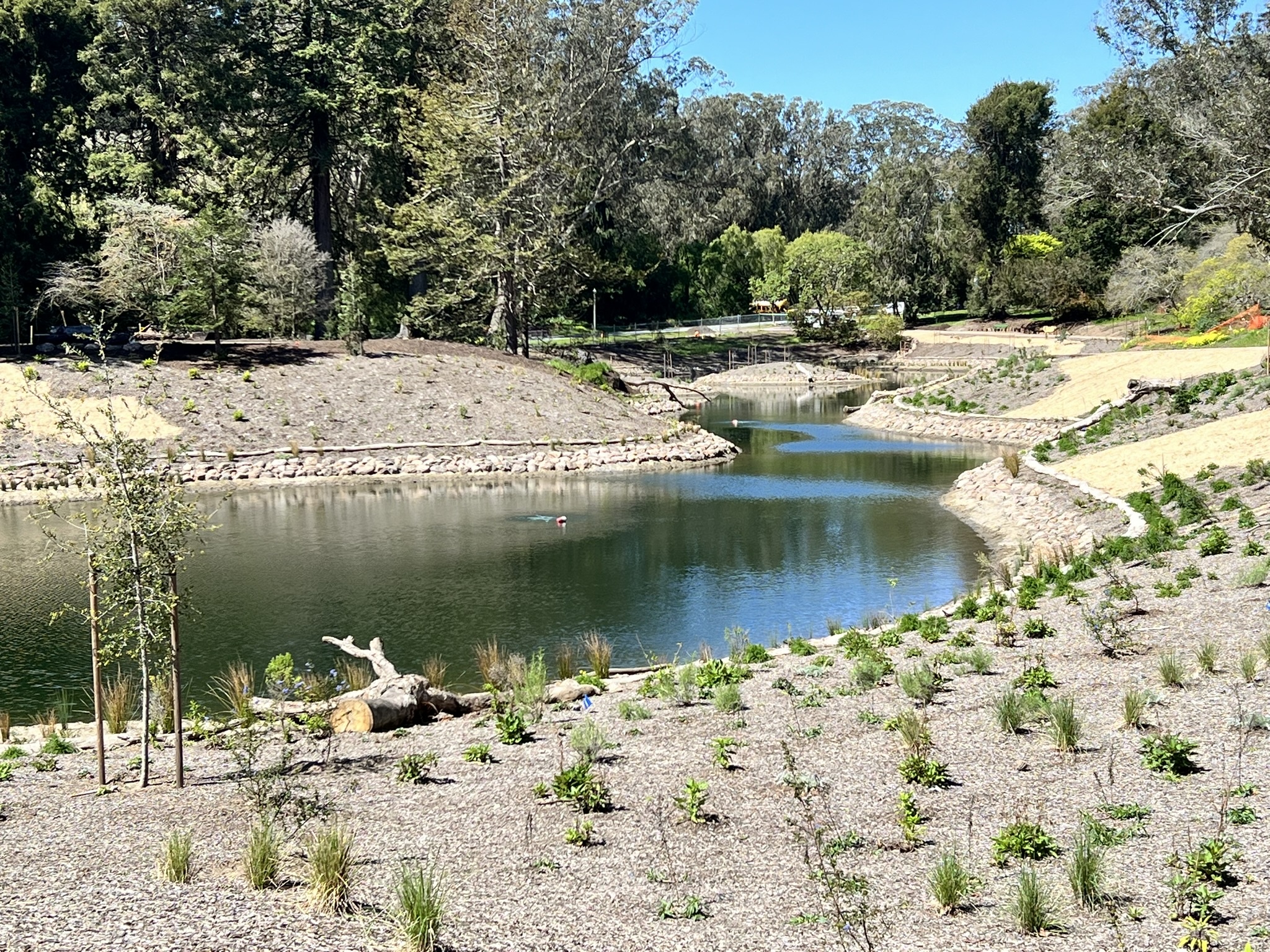
Middle Lake is Rising!
Spring is here and Middle Lake is almost complete and the water level is rising. Now home to aquatic plants, nesting birds and some 12,000 new plants including over 80 native species of trees and understory plants. Soon San Franciscans will be able to stroll around the lake’s edge, over two bridges and along a new cascade within a flowering pacific dogwood grove.
Come visit this summer to enjoy a stroll on the mile long loop trail, a contemplative vista from one of the numerous benches along the lake’s edge, or unroll your picnic blanket on a nearby lawn and listen to the chatter of the birds.
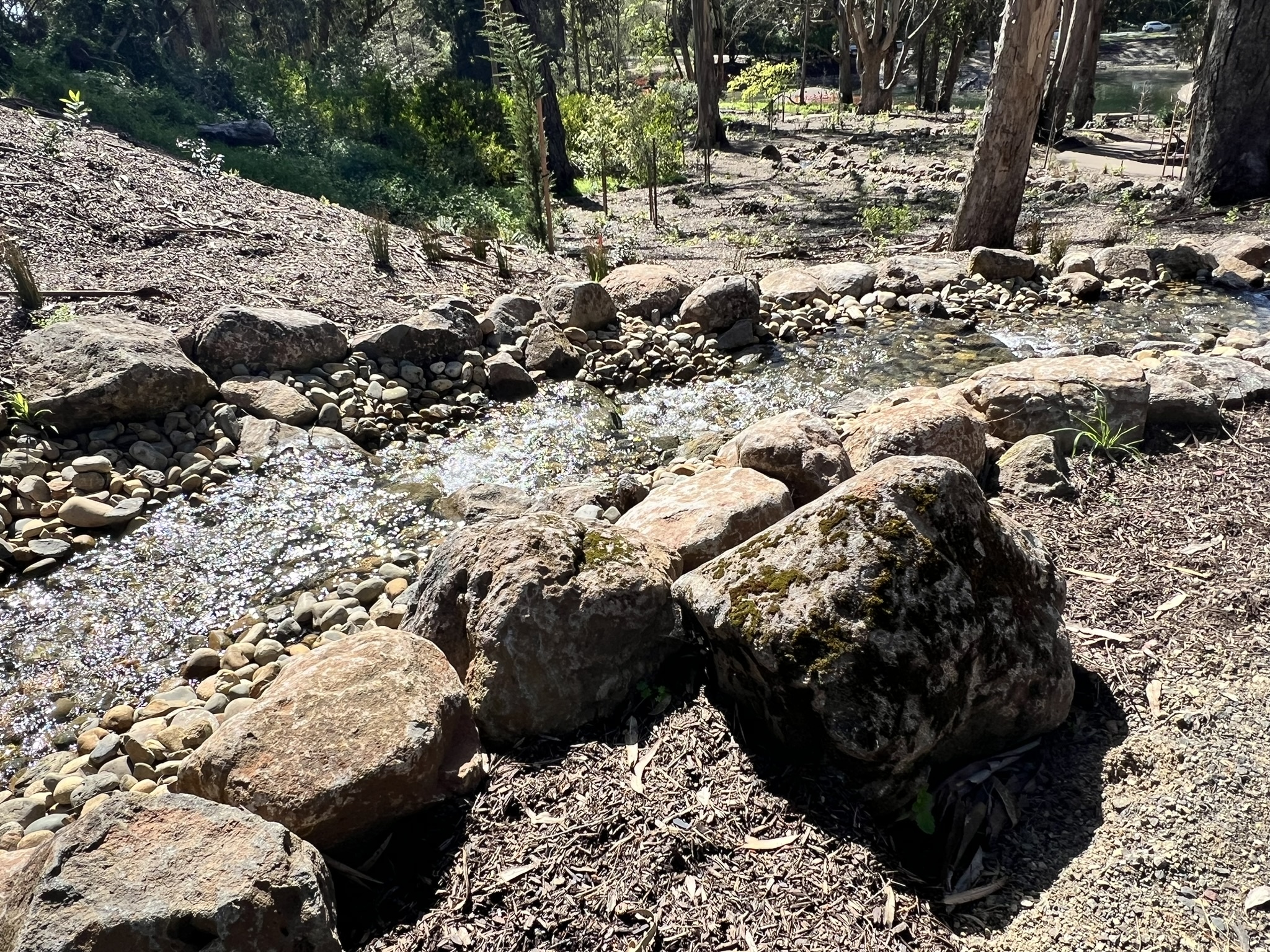

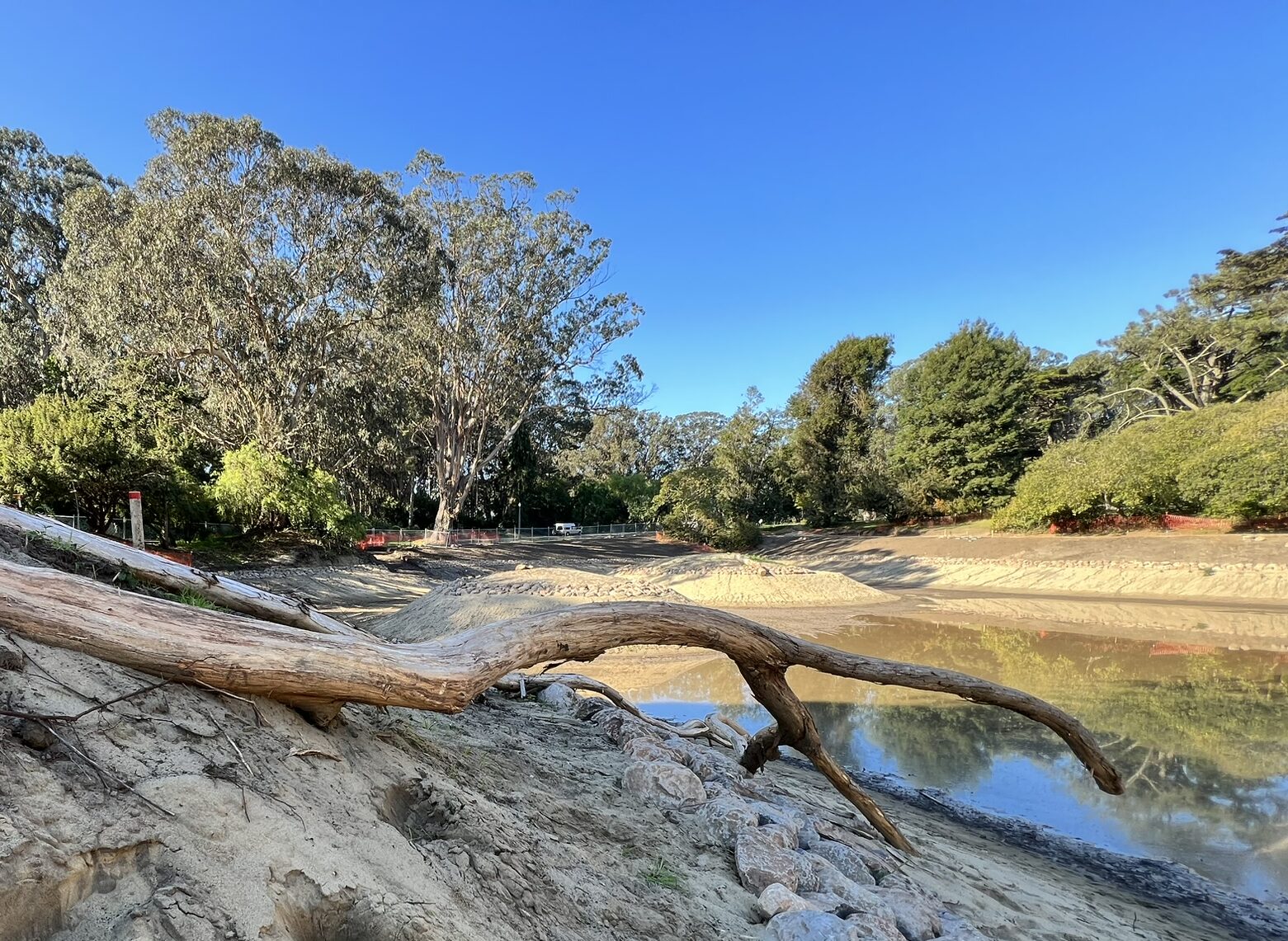
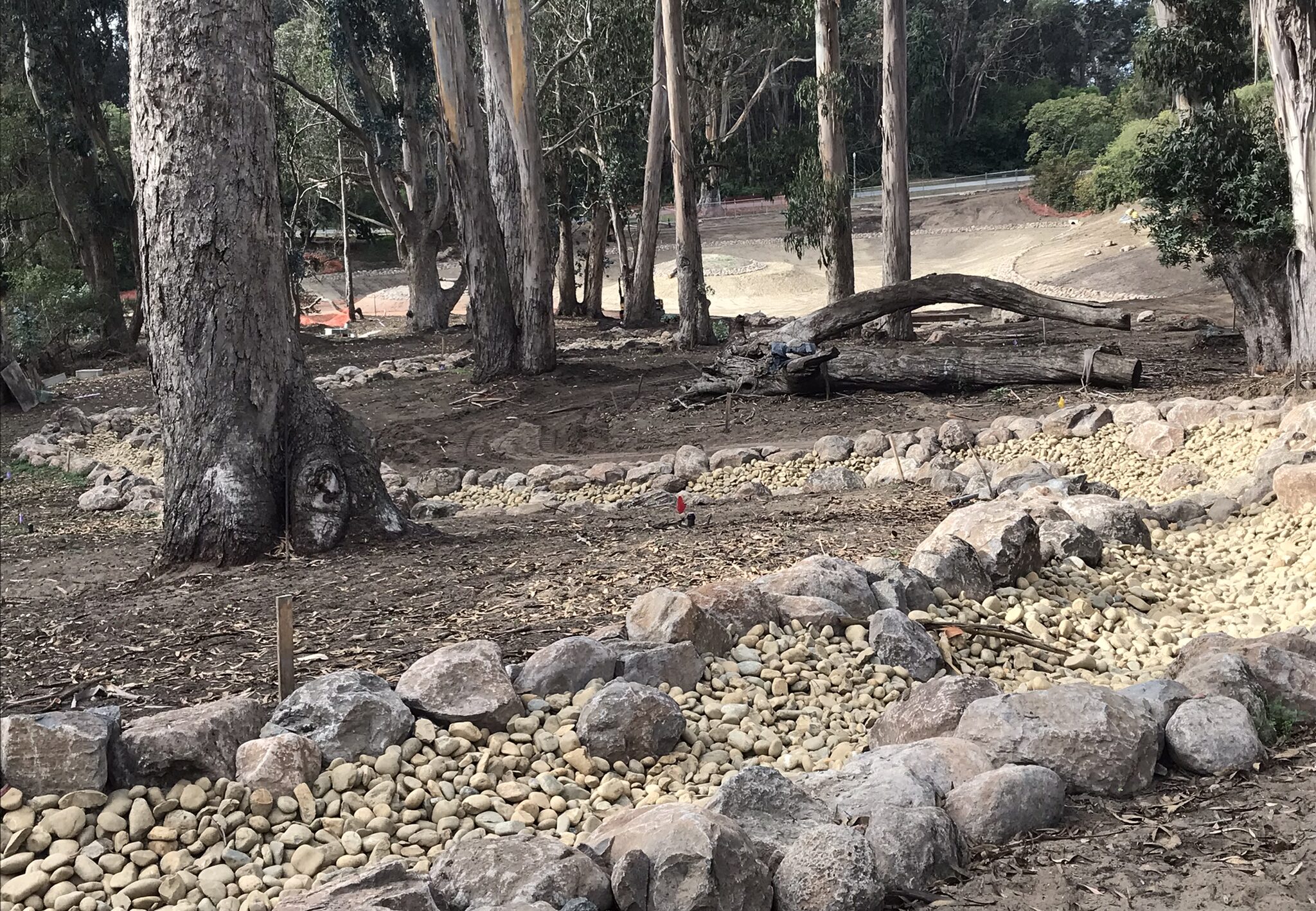
Golden Gate Park’s Middle Lake – Breaks Ground
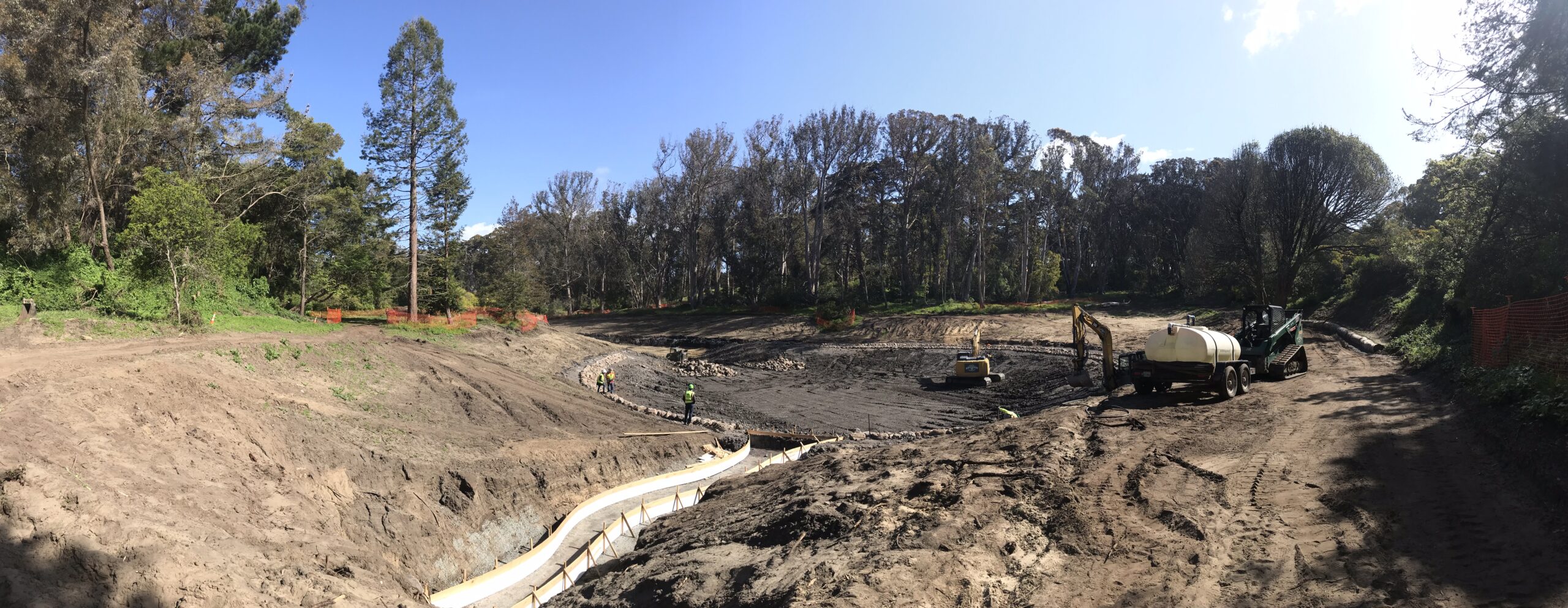
INTERSTICE is proud and excited to be part of the team that is undertaking the restoration of a critical piece of green infrastructure in Golden Gate Park; we are re-building Middle Lake. This freshwater lake is one in a series of three lakes called the Chain of Lakes, which flow north from South Lake, to Middle Lake, and into North Lake at the western end of the park. The original design & construction of these lakes dates back to 1898 and all required a clay liner to hold water over the ancient sand dunes that underlie the park.
Following a year plus long design process, construction of the project began in the early months of 2023 with the selective removal of certain trees and the protection of many other existing mature trees in preparation to rehabilitate the lake.
INTERSTICE, as the landscape architect, is working with Civil Engineers AGS and Woodard & Curran, overseeing the new lake design installation to achieve improved accessibility and enjoyment for park visitors, and a diverse plant and aquatic ecology that will provide improved habitat for insects, birds, amphibians, reptiles and mammals that constitute the spectrum of the wildlife that inhabits and moves through Golden Gate Park. Bauman Construction is the General Contractor leading the construction effort working with the SF Recreation & Parks Department and SF Department of Public Works.
This significant undertaking includes replacing the clay liner lake bottom and increasing the water depth, clearing the pipes connecting Middle Lake to South and North Lakes, and rehabilitating the rock cascade that connects to the Fly Casting Pools.
The new design includes a perimeter loop trail that bridges the cascade, significant and diverse native and aquatic plantings surrounding the lake, furnished seating areas with lookouts along the new pathway which encircles the lake and climbs the slope beside the cascade. The future plantings include over a dozen native tree species, over50 species of native understory plants, including shrubs, groundcovers, grasses, rushes and aquatic and riparian species located at the lakes edge.
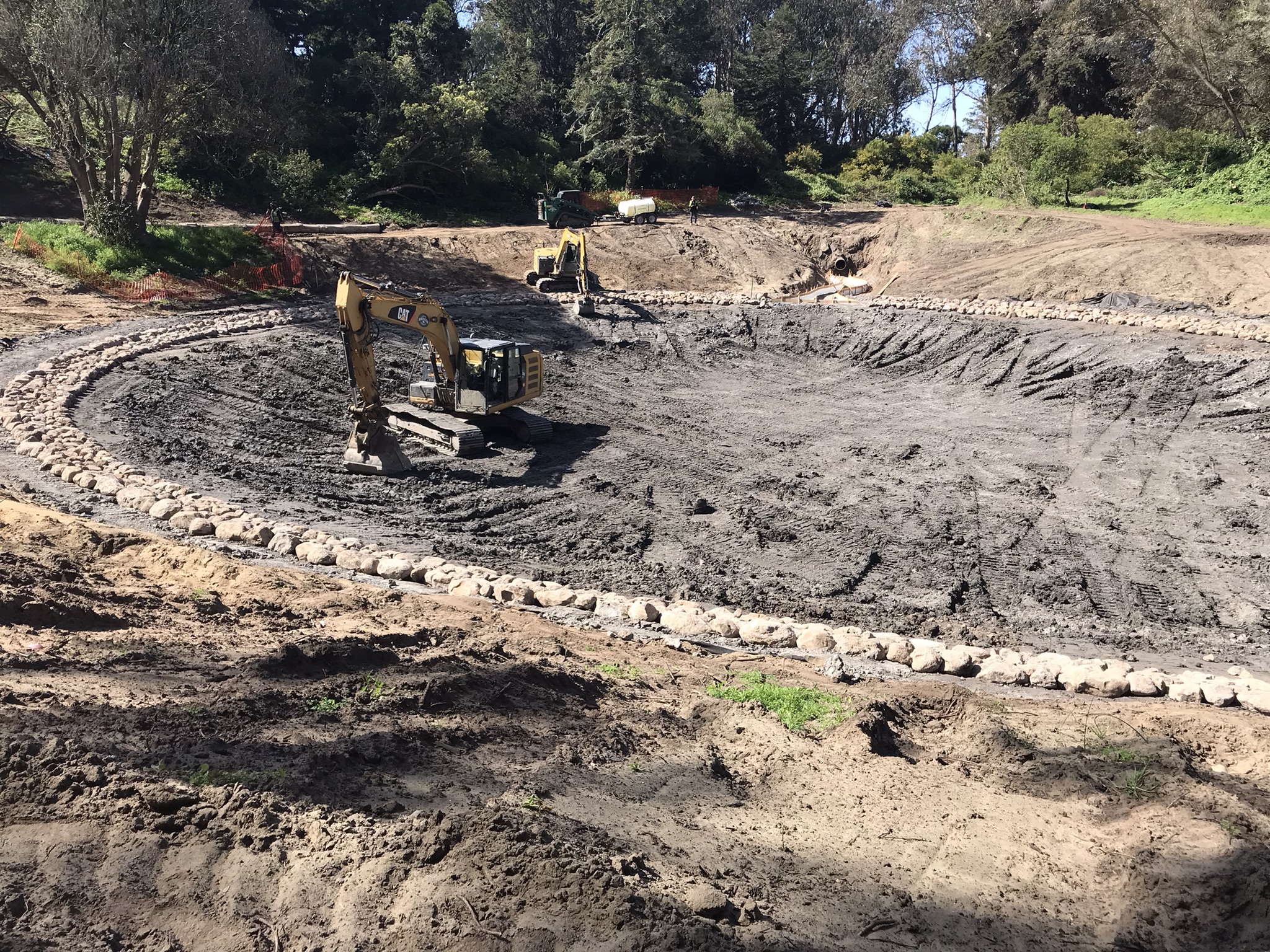
The establishment of the clay liner and lake edge are the first phase and significant part of the work.
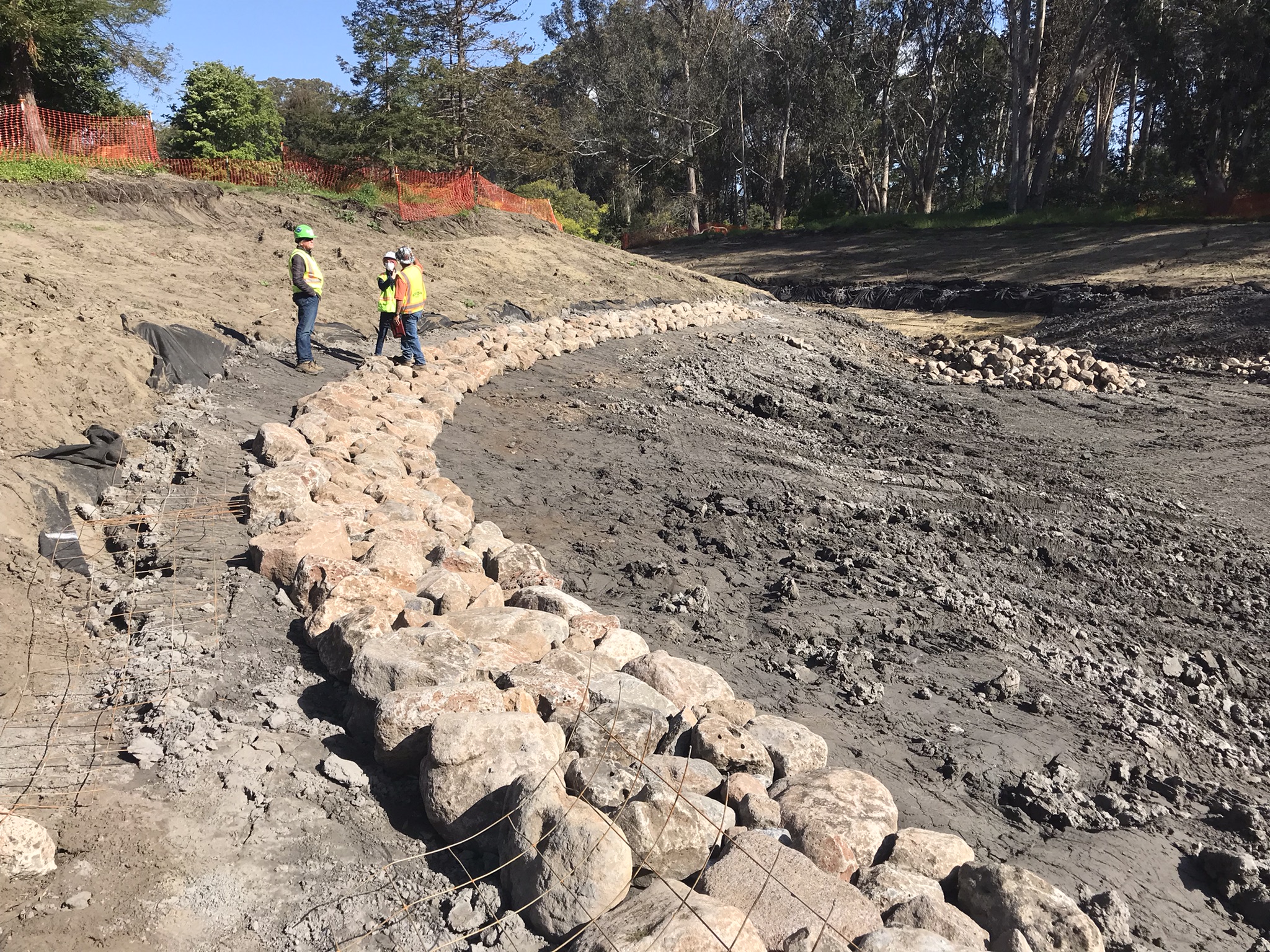
Boulder mock-ups for the lake edge perimeter.
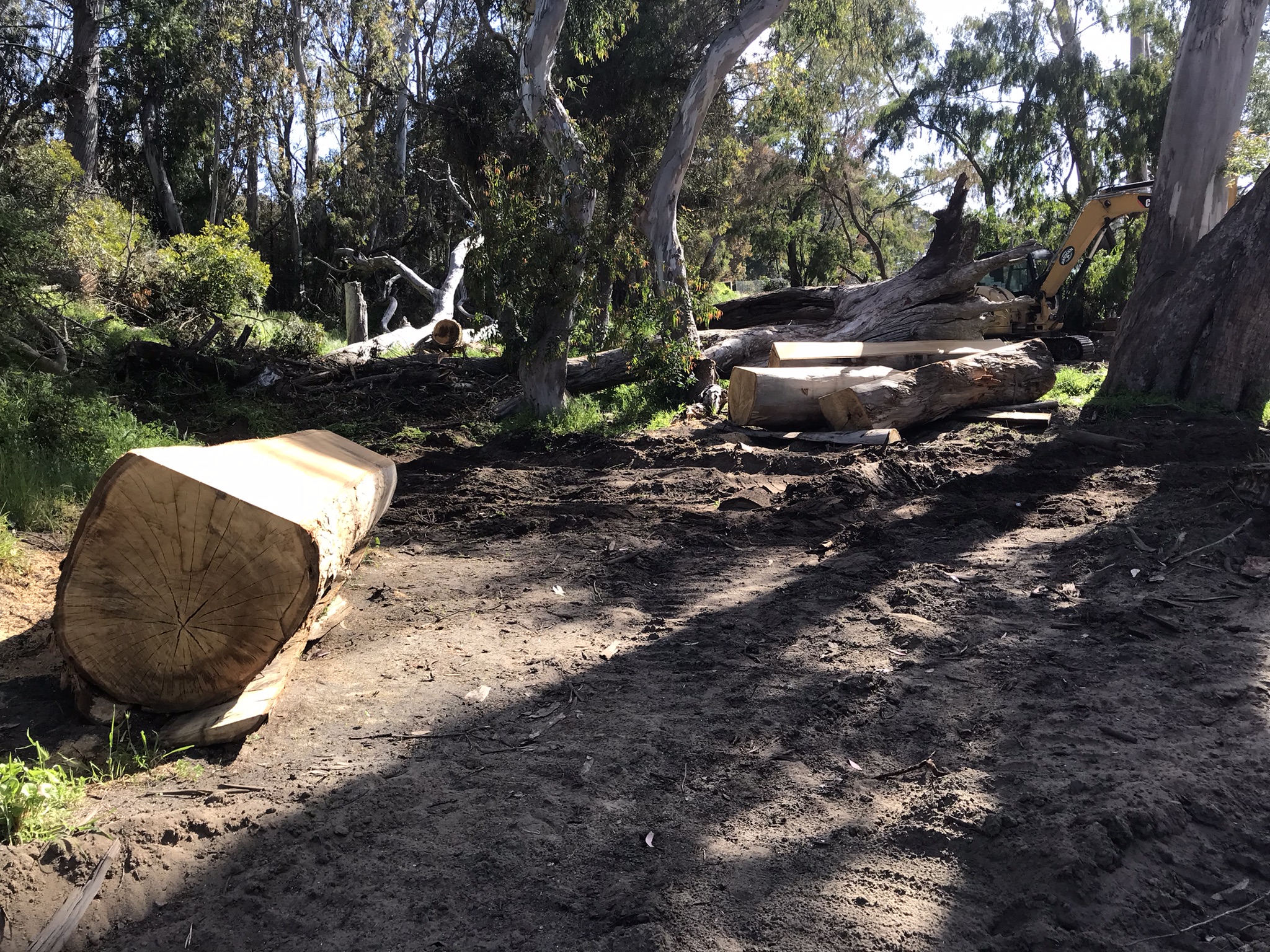
New furnishings being crafted from salvaged trees that were planned for removal or came down in this winter’s storms.
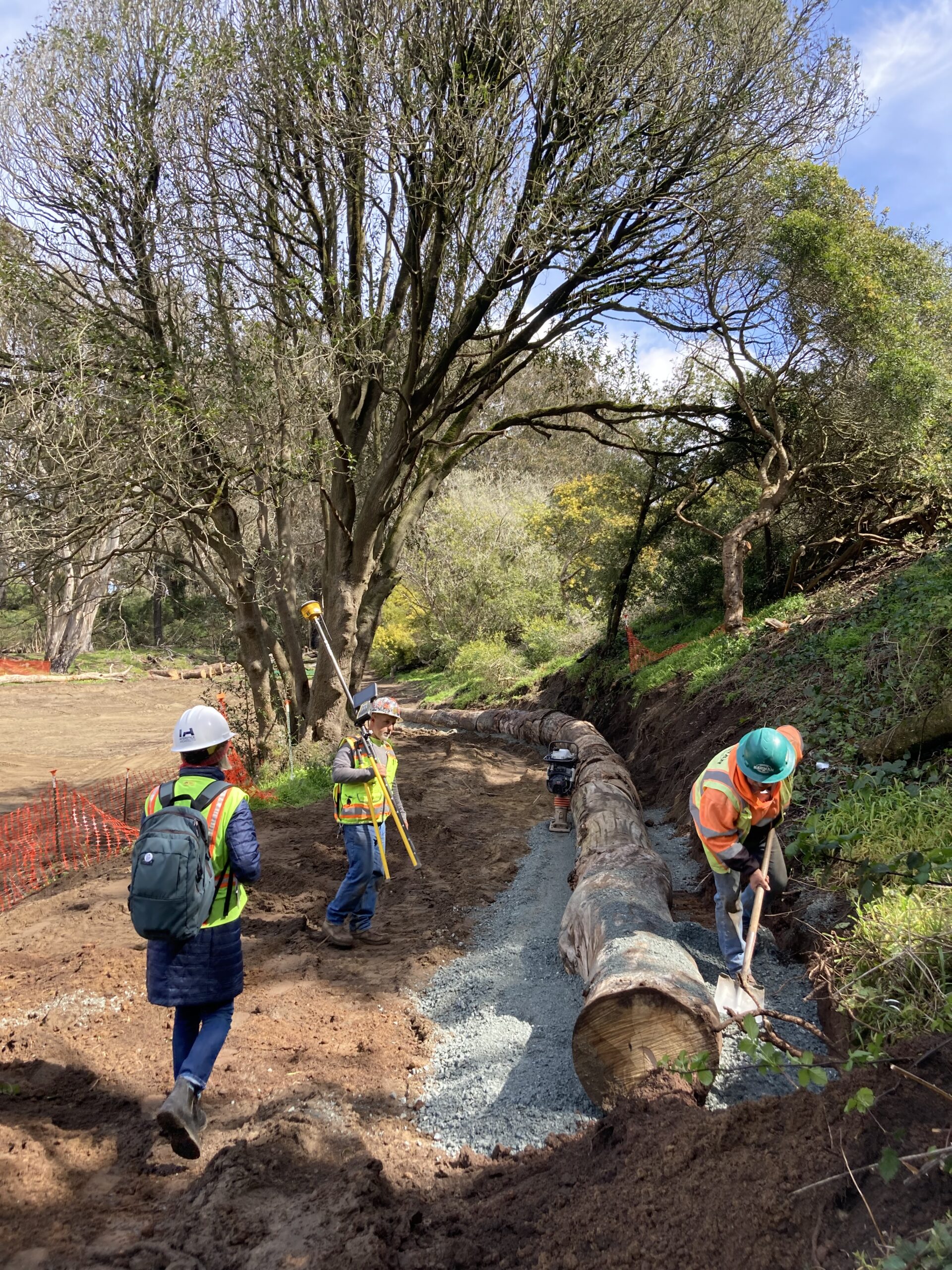
We look forward to sharing more progress as the liner is completed and the lake starts to take shape this Spring.
Amy’s Drive-Thru Construction Well Underway
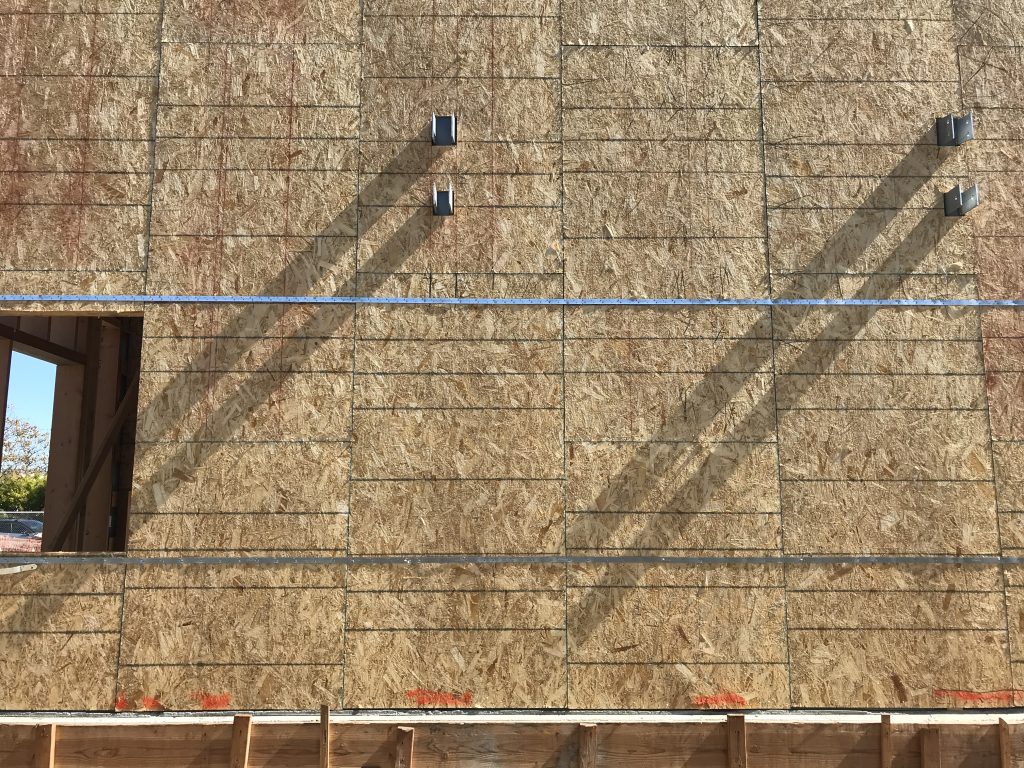
We recently drove up to Corte Madera to take a look at the progress of our Amy’s Drive-Thru restaurant project—and it is starting to take shape! It is now a fully enclosed building: walls, windows, doors, and roof have sprung up this past winter. Currently, electrical systems are being installed and the site is being prepped for paving, plantings, and parking. Amy’s will become the first drive-thru restaurant in the city of Corte Madera, fully supported by the community due to its sustainability as a vegetarian eatery conscious of its environmental impact. The green roof starts installation soon!
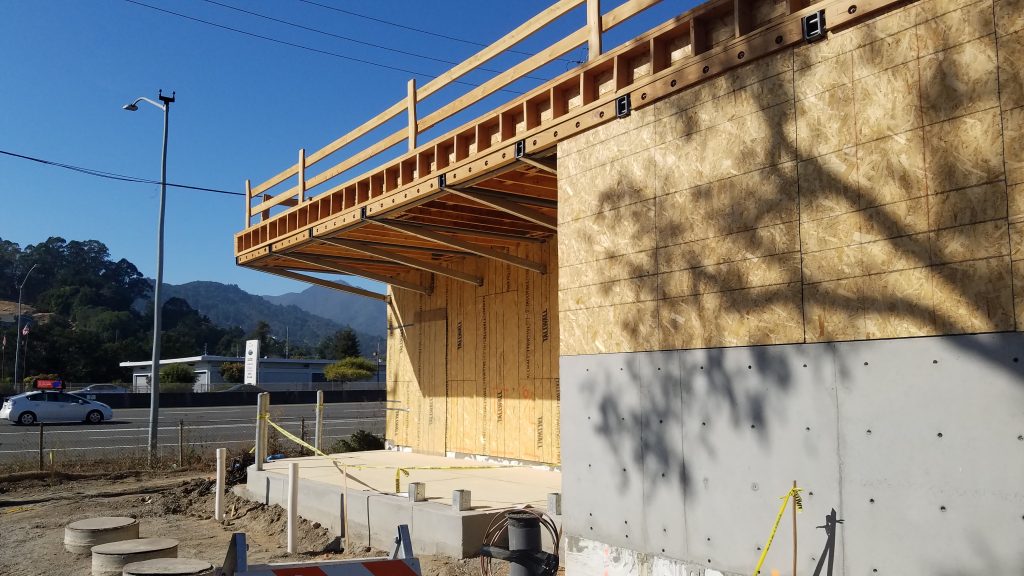
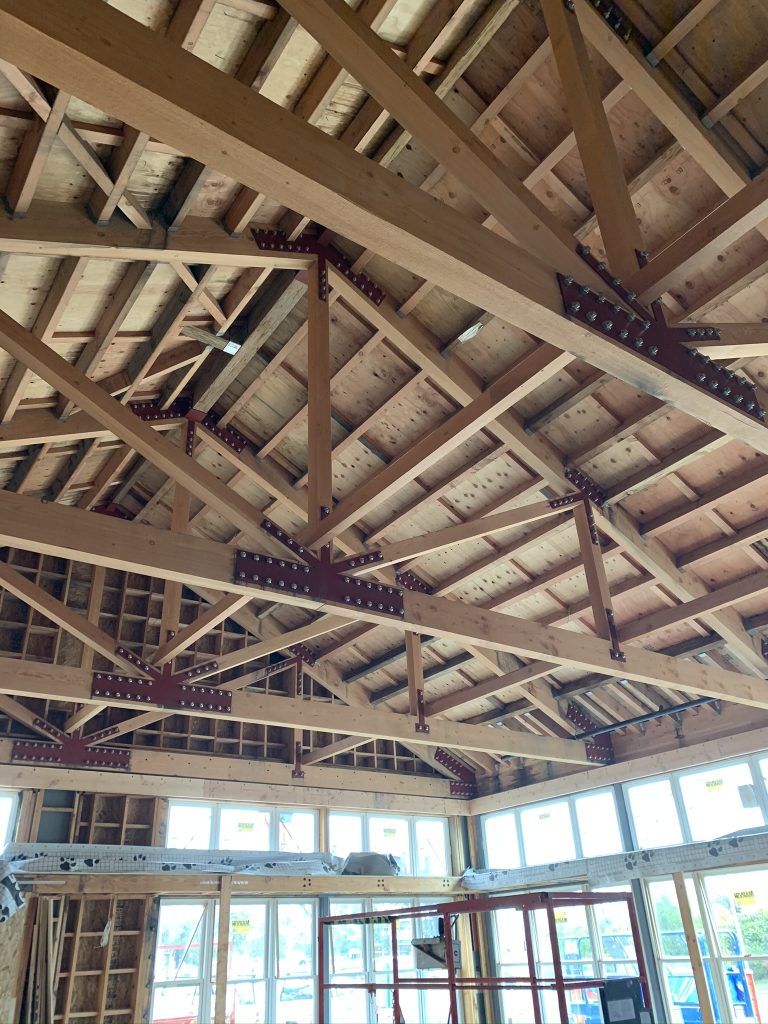
Transbay Block 1 Tower Construction Underway
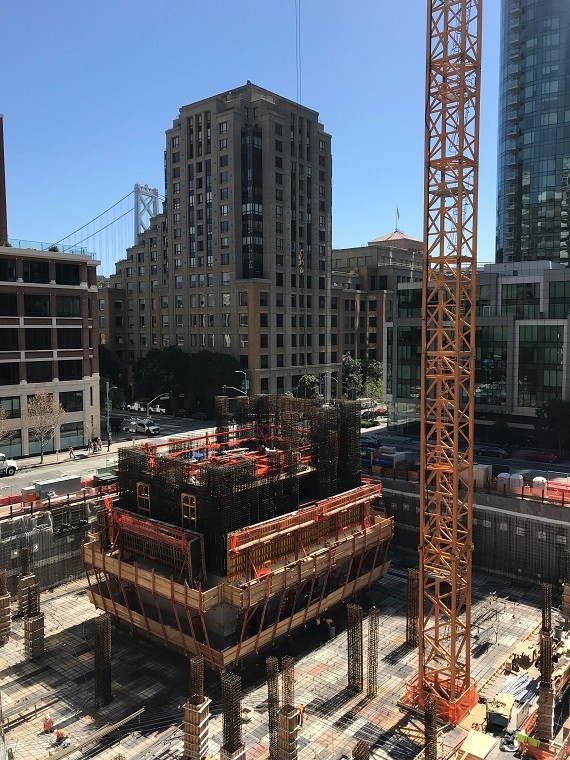
Transbay Block 1 Tower Under Construction
At 160 Folsom, construction is well underway as the first floors of Transbay Block 1 Tower are emerging. This twisting addition to the San Francisco skyline designed by Studio Gang will be completed in 2020. The surrounding landscape, streetscape, alleyway, rooftop spaces, and amenities are designed by INTERSTICE Architects.
This collaborative project pairs sustainability and landscape connectivity with human technology and development. The Ecological Corridor Concept (pictured below) promotes symbiotic relationships between the natural and built environment, connecting the new Transbay corridor park with the Bay. INTERSTICE Architects looks forward to the extended terrain of the alleyways and multiple rooftops taking shape to enhance the city’s civic realm and urban forests.
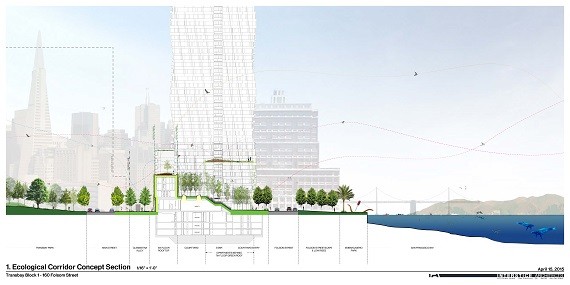
Ecological Corridor Concept
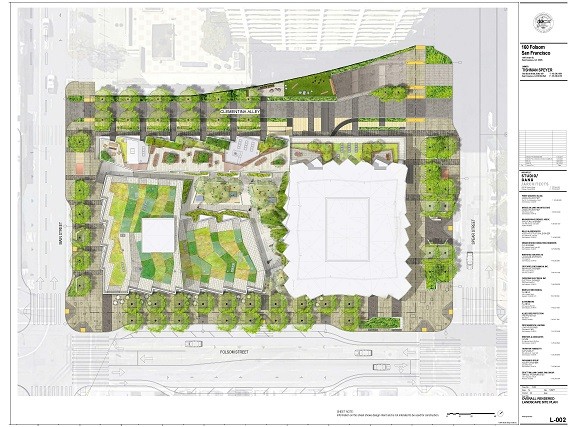
Overall Landscape Plan
2018 Summer Intern Spotlight
IA hosted a group of very special interns this year – three curious, passionate students who became integral to our office and gained valuable, firsthand knowledge of the inner workings of a busy studio.
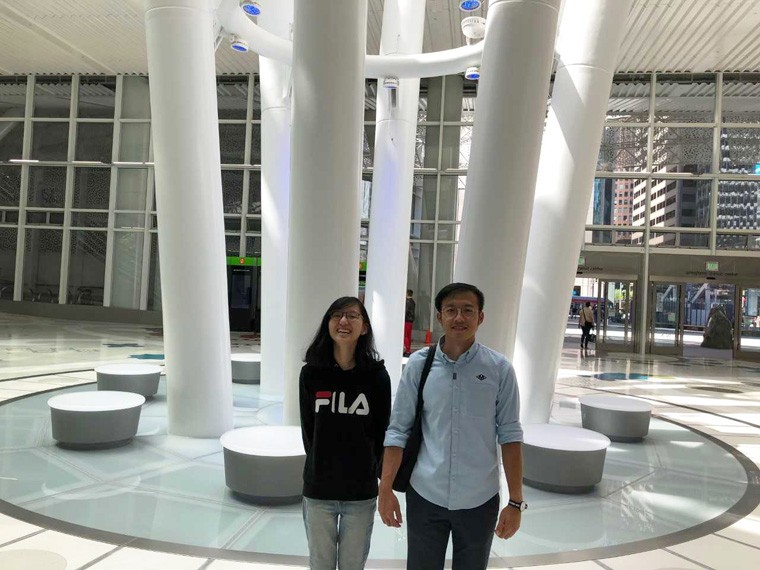
Yuxuan (Left) and Houzhou (Right) at the new Transbay Center
Yuxuan Gu is currently studying landscape architecture at the University of Pennsylvania. She has been an enormous help to the team at IA, providing critical support on our active projects. Yuxuan also came to IA with an undergraduate degree in architecture and was eager to gain experience at a multidisciplinary firm. With an interest in materiality and its effect on the physical experience of space, her favorite tasks at IA included drawing details and learning how to redline construction document sets. She believes these tasks to be a very important aspect of the design process and was excited to gain such valuable firsthand experience. Once Yuxuan completes her MA studies at Penn in 2019, she hopes to continue to work within multidisciplinary practice, where she is able to contribute to various facets of the built environment.
Haozhou Yang also came to IA from the University of Pennsylvania, and will be receiving his masters of architecture degree in December of this year. Houzhou became an integral part of IA’s tight-knit team, lending his support to different projects of varying sizes and at different phases. Haozhou really enjoyed the diversity of the firm’s project typologies , and he was excited to be able to learn Revit in such a hands-on environment. The greatest lesson he took away from working at IA is that communication is such a critical part of the design process, at every stage of a project, which is a lesson that he will carry with him throughout his career. Haozhou cited the elegant, detailed based solutions that he helped work on with the team at IA as being the most rewarding part of his time at the firm.
Enterprise for Youth Internship Program Intern – Gavin Li
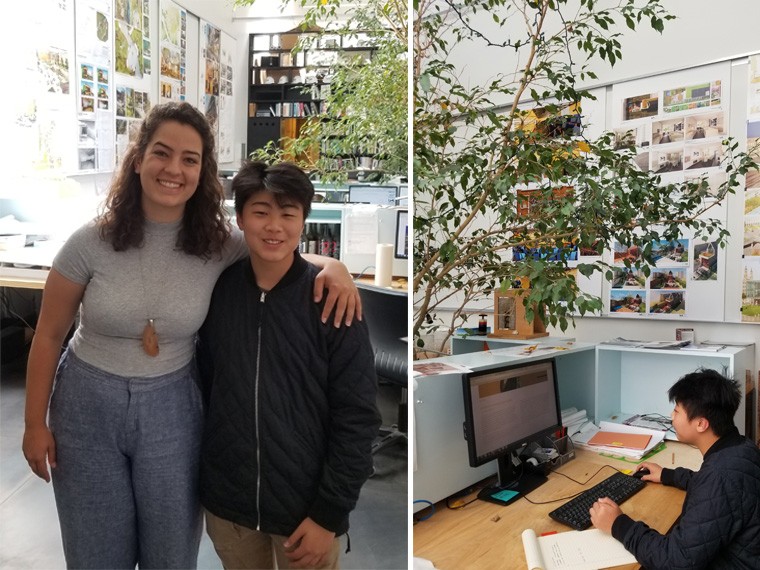
Gavin Li at the IA office
For the second year in a row, INTERSTICE Architects participated in the Enterprise for Youth internship program, which empowers local youth to prepare for and discover career opportunities. Through this program, youth cultivate their individual interests and potential through training, guidance, and employment experiences in supportive and diverse environments. This summer, IA had the privilege of hosting Gavin Li, a recent graduate of Lincoln High School and who is starting as a freshman at Ohlone College this fall. As an intern this summer, Gavin was an immense help and an enthusiastic addition to the IA team. Learning about architecture while a senior at Lincoln High school, he was quickly inspired by the physical and emotional resonance of the built environment. This new found interest was enhanced further by a post-graduation trip to Greece, experiencing some of humanity’s greatest artistic and architectural achievements.
During his time at IA, Gavin’s was given first-hand experience of what it means to work in architecture – from sitting in on client and consultant meetings, going on site visits, and participating in design sessions with his coworkers. He was interested to learn that the design process is fundamentally about problem solving, and was inspired by the creative solutions that were devised in response to the whole host of challenges that inevitably arise throughout the design process. He cited our 160 Folsom Street project as a personal favorite, especially because he passes it every day on his commute and has witnessed the progress of the project firsthand.
IA Team Volunteers in the Presidio
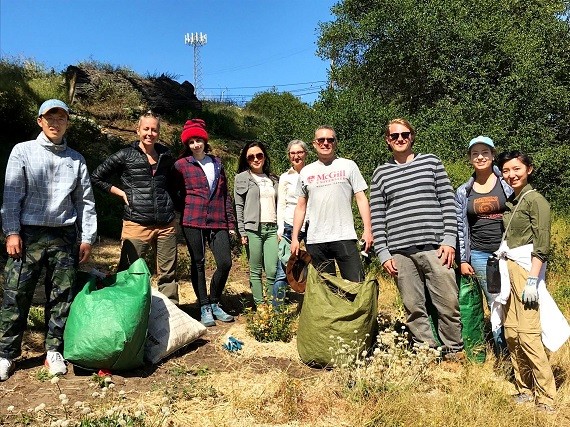
Recently, INTERSTICE switched up their usual routine by getting outside and getting involved. They headed due north to work with Golden Gate Parks National Conservancy on a habitat restoration project in The Presidio. The project was located at Wherry Corridor, a narrow section of natural habitat threading between man-made structures. For the past 15+ years, the Golden Gate Parks National Conservancy has been nurturing this area back to a healthy landscape filled with native flora and fauna. INTERSTICE assisted with watering and weeding new growth and removing invasive plant species. Not their first volunteering project in the Presidio, INTERSTICE once again enjoyed the opportunity to improve their local habitat.
PARK(ing) Day 2017 – Mirror Mylar Forest-Field
PARK(ing) Day 2017 – Mirror Mylar Forest-Field: Pedestrian Safety Along the Polk Corridor
For Park(ing) day 2017, INTERSTICE Architects created an interactive Park(ing) Day installation on Polk Street at Hemlock Alley. Visitors experienced the wind-activated Mirrored Mylar Forest to explore questions of pedestrian safety and share their experiences of being a San Francisco pedestrian. Which spaces are prioritized for pedestrians? Where is there room for improvement?
Recording individual experiences as a pedestrian, cyclist or driver, the public was asked to register their information directly onto the installation surface. An enlarged a map of the Polk Street Corridor [built from data collected from the California Highway Patrol & highlighting pedestrian-related traffic incidents] created the “ground” for discussion. This interactive pedestrian Park(ing) map evolved throughout the day as a palimpsest that visitors could walk through – orienting themselves within the parking space, the neighborhood, and the city streets.
The installation was inspired by the Polk Streetscape Improvements recently underway and INTERSTICE’s collaboration as part of an initiative to enrich The Lower Polk Alleyways District. The new Lower Polk Alleyways Vision Plan (LPADVP) recently adopted by the Lower Polk Neighbors, proposes a future vision for the 12 blocks of alleyways located within the boundaries of the Lower Polk Neighborhood. INTERSTICE Architects guided this community-driven process which has resulted in a unique community-initiated set of strategies and guidelines designed to understand these alleyways, not as singular back-streets or isolated funding opportunities, but instead to consider them as a whole – as a District.
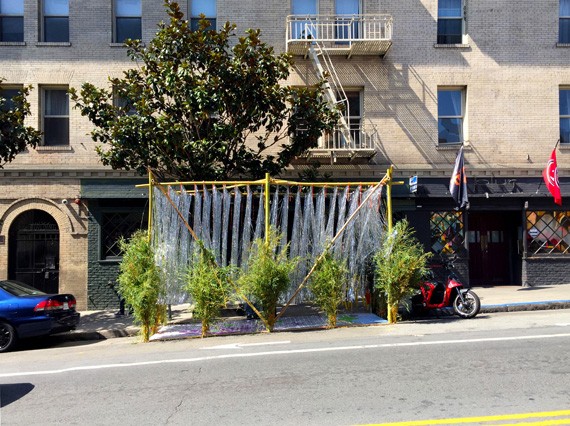
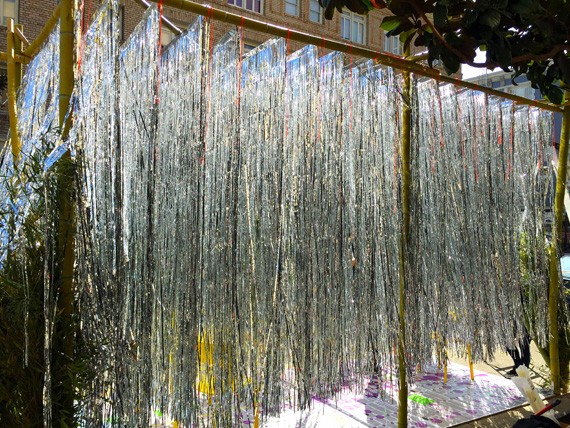
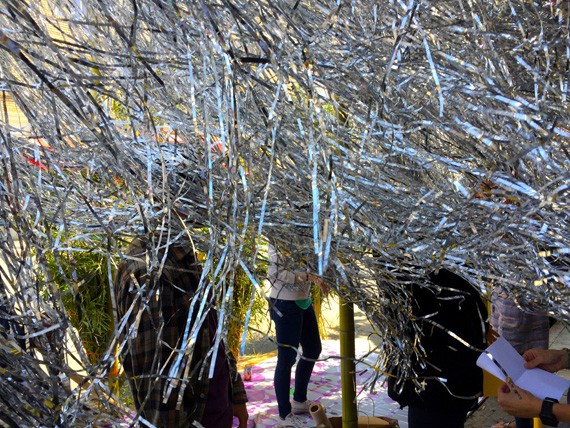
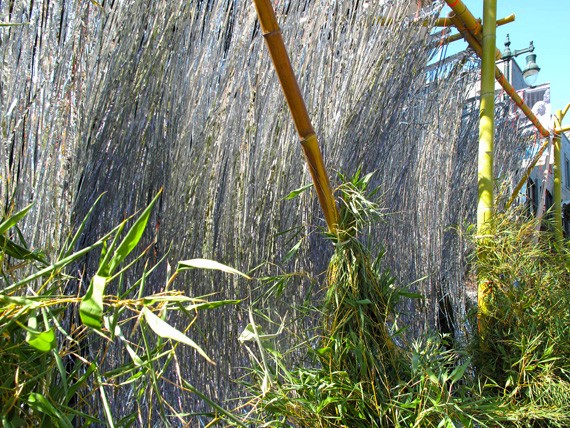
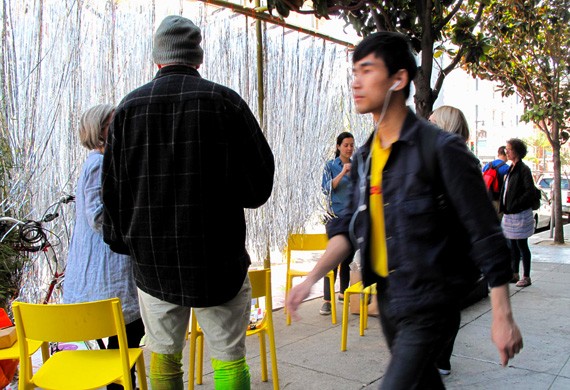
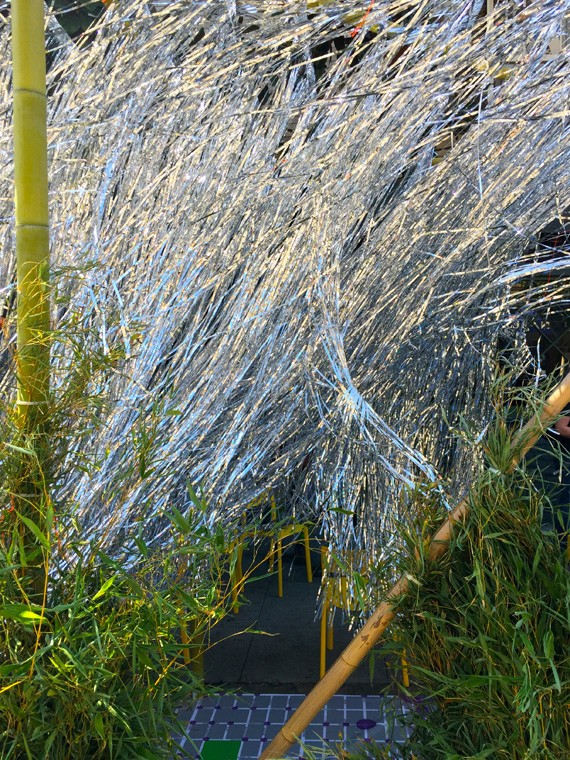
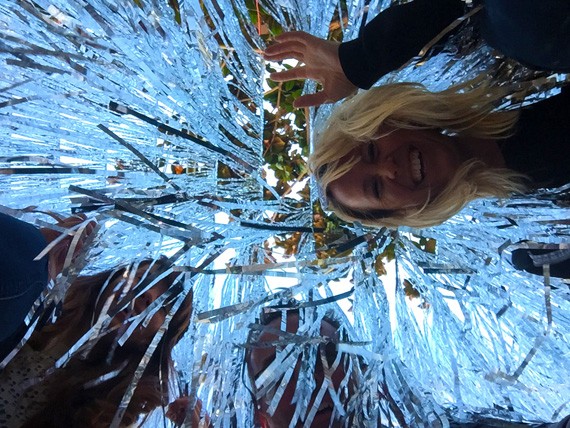
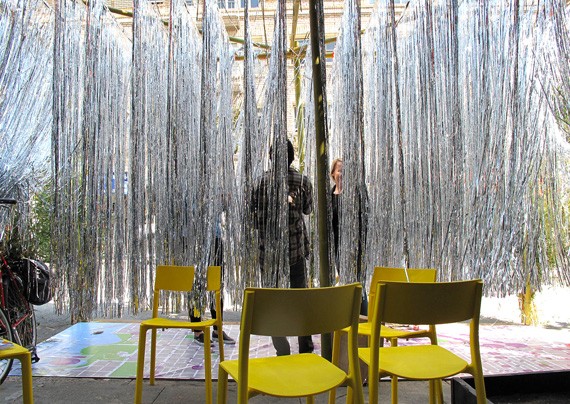
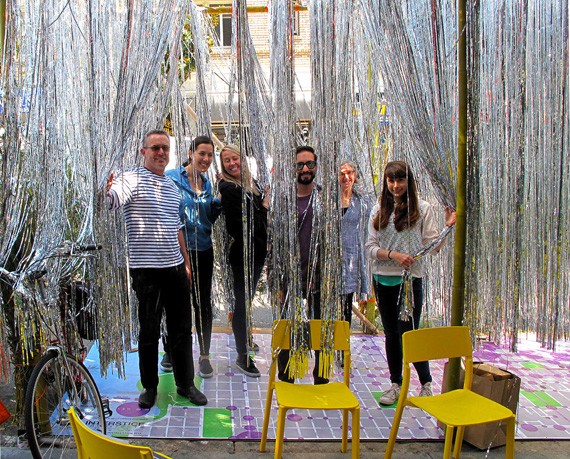

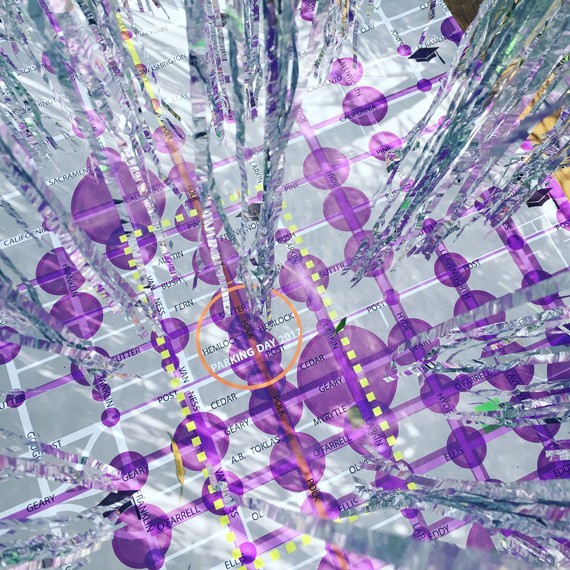


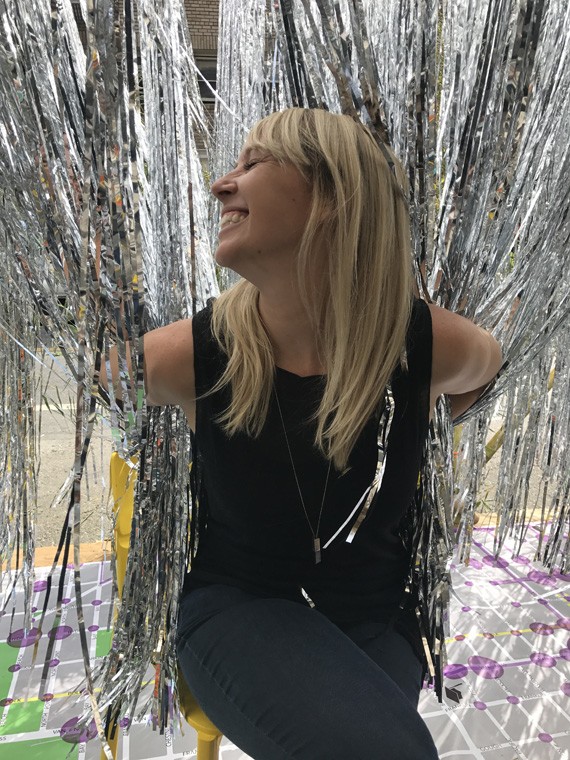

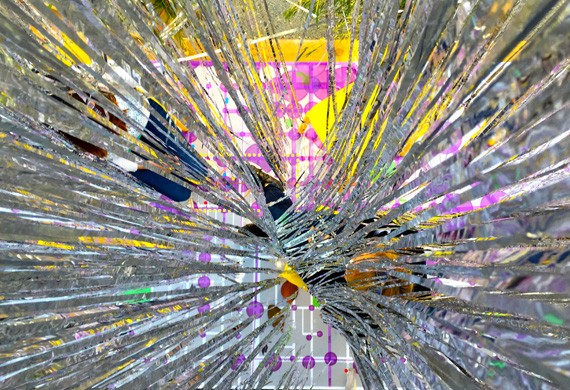
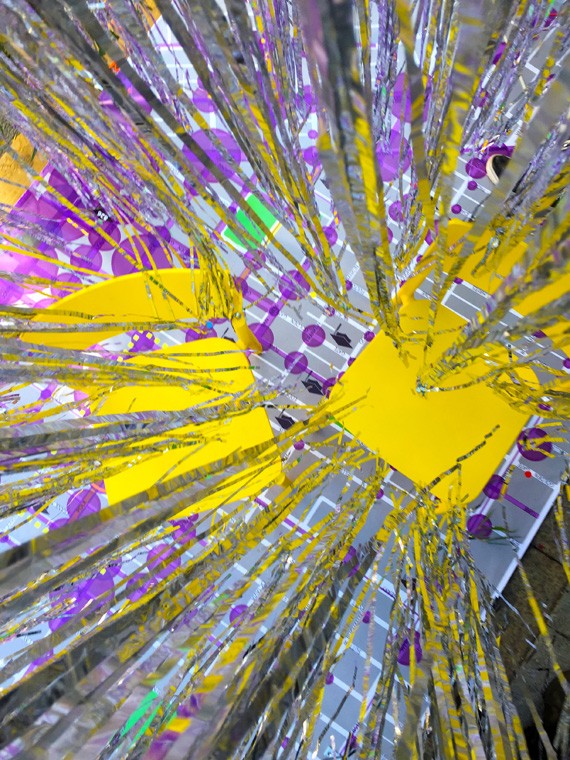
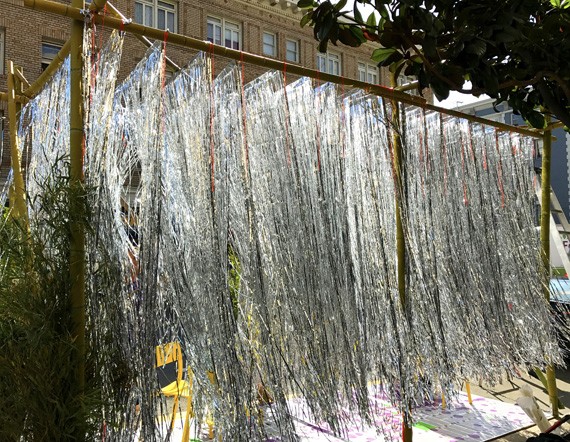
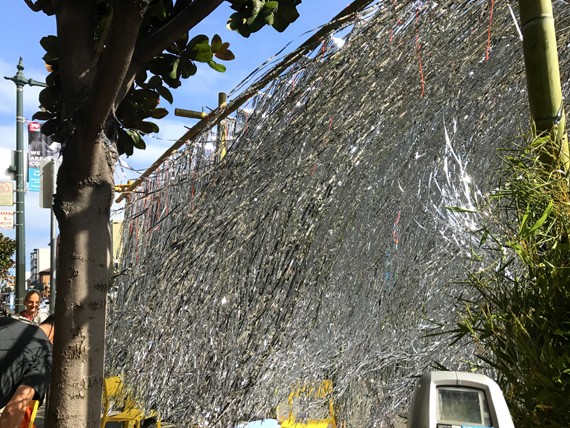
Alleycat Bench Fabricator Visit
We paid our fabricator a visit to see the progress being made on the prototype for our Alleycat Bench – a dynamic bench that folds down for general public use, and folds up and locks after hours. Check out some of the images from our visit!

